Bavaria
![]()
The title of this article is ambiguous. For other meanings, see Bavaria (disambiguation).
The Free State of Bavaria (![]()
![]() [ˈbaɪ̯ɐn]; state code BY) is the largest of the 16 states in Germany, with an area of more than 70,500 square kilometers, and is located in its southeast. With more than 13 million inhabitants, it is the second most populous German state after North Rhine-Westphalia.
[ˈbaɪ̯ɐn]; state code BY) is the largest of the 16 states in Germany, with an area of more than 70,500 square kilometers, and is located in its southeast. With more than 13 million inhabitants, it is the second most populous German state after North Rhine-Westphalia.
In the south, the Free State has a share in the high mountains of the Eastern Alps and in the flat Alpine foothills reaching as far as the Danube. North of the Danube, the landscape is dominated by low mountain ranges such as the Bavarian Forest and the Fichtelgebirge.
The largest cities in Bavaria by population with the highest number are first Munich, Nuremberg, Augsburg, Regensburg, Ingolstadt and Fürth. Bavaria has two centers of European metropolitan regions, the metropolis of Munich with an agglomeration of 2,211,800 and 5.71 million inhabitants in the metropolitan region, and the metropolis of Nuremberg with an agglomeration of 1,206,200 and 3.56 million inhabitants in the metropolitan region. In addition, Bavaria has Augsburg, a metropolis with half a million inhabitants and an agglomeration of 510,100. Other major cities are Würzburg and Erlangen.
Bavaria is a parliamentary republic with the Bavarian State Parliament as the legislative branch and the Bavarian State Government, headed by the Minister President as the head of government, as the executive branch. The basis of the policy is the constitution of the Free State of Bavaria, according to which Bavaria is a people's, legal, cultural and social state. The designation Free People's State or Free State as a republic has been borne by Bavaria since 1918 with the proclamation by the revolutionary Prime Minister Kurt Eisner on November 8, 1918 and the associated end of the Kingdom of Bavaria.
As early as 555 A.D., and thus about 500 years before the term German was used in the modern sense, there is evidence of the older Bavarian tribal duchy, which became part of the Frankish domain under the Merovingians. Under the Carolingians, a Bavarian kingship emerged for the first time, which they either ruled in personal union as kings or sub-kings or appointed governors. After the end of the rule of the Carolingians, the Bavarian independence strengthened in the younger Bavarian tribal duchy. With the beginning of the rule of the Wittelsbach dynasty in 1180, the transition to a territorial state followed. They ruled Bavaria for over 700 years until 1918. Bavaria was an electorate of the Holy Roman Empire and from 1806 a kingdom. The constitutions of 1808 and 1818 made Bavaria a constitutional monarchy. As one of the victorious powers at the Congress of Vienna in 1814, Bavaria was able to retain a large part of the territorial gains; among other things, Upper, Middle and Lower Franconia, parts of Swabia and the newly created Palatinate on the left bank of the Rhine became part of Bavaria. In 1918, the Wittelsbach monarchy collapsed in the November Revolution. After occupation by the U.S. Army, Bavaria became part of the newly founded Federal Republic in 1949. The Palatinate was separated from Bavaria in 1946 and is now part of Rhineland-Palatinate. An economic upswing and a development from an agricultural state to a modern industrial state began.
Bavaria lies almost entirely in the Upper German-speaking region. Traditionally, it is divided into three parts: Franconia (today the administrative districts of Upper, Middle and Lower Franconia), Swabia (administrative district of the same name) and Old Bavaria (administrative districts of Upper Palatinate, Upper and Lower Bavaria).
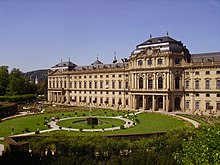
Würzburg
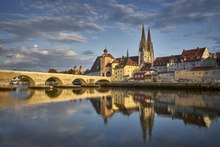
Regensburg

Augsburg

Nuremberg
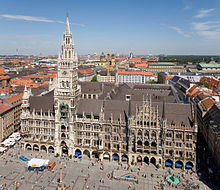
Munich
Geography
Territory and landscape
As a landlocked state, Bavaria borders the following countries: the Czech Republic to the east, Austria to the southeast and south, and Switzerland indirectly to the southwest via Lake Constance. In addition, there are the German states of Baden-Württemberg (in the west), Hesse (in the northwest), Thuringia (in the north) and Saxony (in the northeast). The state border of Bavaria is 2705 kilometers long in total. Starting in the west, Bavaria borders clockwise on Baden-Württemberg (829 kilometers of border), Hesse (262 kilometers), Thuringia (381 kilometers), Saxony (41 kilometers), the Czech regions of Karlovy Vary, Pilsen and South Bohemia (357 kilometers), the Austrian states of Upper Austria, Salzburg, Tyrol and Vorarlberg (816 kilometers) and the Swiss canton of St. Gallen (19 kilometers), although the course of the border in Lake Constance is not fixed.
Until 1990, the border to Thuringia, Saxony and the former Czechoslovakia formed a section of the Iron Curtain. Due to the border fortifications, it represented a physically almost insurmountable separation between NATO and the Warsaw Pact. At Prex there was a border triangle. Not part of the Bavarian territory and therefore not part of the German territory are the Saal forests located in Austria, which are owned by the Free State of Bavaria under private law. On the other hand, the Cheb municipal forest, which historically belongs to the Bohemian town of Cheb, is part of the Bavarian territory and is administered by a foundation.
Bavaria is located in southern Germany and includes:
- the Bavarian Alps in the south
- from there north the alpine foreland to the Danube with the three big lakes of Upper Bavaria
- the eastern Bavarian low mountain range and
- the stepped landscape of the Swabian and Franconian Alb.
The Bavarian Alps in the extreme south of Bavaria belong to the Northern Limestone Alps. Bavaria is the only German state that has a share of the Alps. Usually, the Bavarian Alps are understood to be only the mountainous parts located between the rivers Lech and Saalach. In this narrower sense, therefore, the Allgäu Alps, to which the Bavarian territory has only recently extended, and the Berchtesgaden Alps do not belong to the Bavarian Alps. It should not be confused with the concept of the Bavarian Pre-Alps, which border the mountains to the north. The latter include only the Bavarian portion of the Prealps between the Loisach River in the west and the Inn River in the east. While the Pre-Alps have only isolated pronounced limestone rock faces, the Alps are characterized by the cirques, lakes and typical U-shaped valleys formed by glaciers during the Late Pleistocene. Deposits from the ice-age rivers and, above all, the glaciers gave rise to a hilly landscape with lakes and moors, especially in the Alpine foothills. This is where, for example, the Chiemgau, the Fünfseenland and the Allgäu are located.
While between the Alps and south of the Danube the terrain is flat to hilly, north of them lie several mountains that reach heights of over a thousand meters, including, for example, the Bavarian Forest with the Great Arber as the highest mountain in Bavaria outside the Alps and the Fichtel Mountains with the Schneeberg as the highest mountain in Franconia. The Franconian Alb as a geological continuation of the Swiss Jura and the Swabian Alb stretches around an arc through the north of Bavaria and shields parts of Franconia from Old Bavaria. To the north of it lie numerous witness mountains such as the Hesselberg. The far southwest of the Alb borders the Nördlinger Ries, remnant of an impact crater formed during the Ries event about 14.6 million years ago. The Franconian Keuper-Lias region, which includes the Aischgrund, Steigerwald and Frankenhöhe, merges with the Main Franconian Plates. Southwest of it lie the low mountain ranges Odenwald, Spessart and Rhön. The eastern half of Bavaria is characterized by low mountain ranges such as the Bavarian Forest or the Franconian Forest. There you will find the largest non-dissected forest area in Central Europe. Parts of the Vogtland are located in Bavaria. The western part of Lower Franconia as part of the Rhine lowlands belongs to the Bavarian Lower Main.
The lowest point in Bavaria is the water level of the Main River in Kahl am Main (Lower Franconia) at 100 m, the highest on the summit of the Zugspitze (2962 m), the highest German mountain located in the Wetterstein Mountains. All 30 highest mountain peaks in Germany are located in the Bavarian Alps, concentrated in the Wetterstein Mountains, the Berchtesgaden Alps and the Allgäu Alps. The highest Bavarian peaks are the Watzmann (2713 m) in the Berchtesgaden Alps and the Hochfrottspitze (2649 m) in the Allgäu Alps.
The geographical center of Bavaria is located about 500 meters east of the market town of Kipfenberg in the district of Eichstätt (location48.94660711.404567). Historically, several places in Bavaria considered themselves the center of Europe. Since Croatia's accession to the EU on July 1, 2013, the geographic center of the European Union has been in the district of Aschaffenburg, in the Oberwestern district of the Bavarian municipality of Westerngrund (location50.1172869.247768). It had shifted by 500 meters due to the accession of the French overseas department of Mayotte, a group of islands in northwestern Madagascar (location50.680049.151501). Since the withdrawal of the United Kingdom on January 31, 2020, the EU center is located in the district of Würzburg, in the Gadheim district of the municipality of Veitshöchheim (location49.8430569.901944).
See also: List of mountains in Bavaria, List of landscapes in Bavaria and List of menhirs in Bavaria.
Waters
The most important river in the country is the Danube, which flows from west to east in the southern half of the country, entering the territory of the country at Ulm and crossing over into Austria at Passau. Its largest tributaries are (downstream):
- Iller, Lech, Isar, Inn (from south)
- Wörnitz, Altmühl, Naab and Regen (from north)
The four southern tributaries originate in the Alps and are more watery. The Inn and Lech (because of their long upper reaches) usually carry somewhat more water than the Danube at their mouths.
In local history classes, the following mnemonic is recited about the Danube in many places: "Brigach and Breg take the Danube away. Iller, Lech, Isar, Inn, flow to the right towards the Danube. Wörnitz, Altmühl, Naab and Regen flow to the left against it."
Most of Franconia is drained by the Main from east to west into the Rhine. In its strikingly curved course, it forms the so-called Main Triangle and Main Quadrangle. Its largest tributaries are the Regnitz and Tauber from the left and the Franconian Saale from the right. The left tributaries of the Elbe, the "Saxon" Saale and the Eger rise in the northeast of Upper Franconia.
In the terminal moraine landscapes in the southern part of the northern Alpine foothills, there are many lakes, some of which protrude into the mountains, such as Lake Tegernsee, Lake Starnberg and Lake Schliersee. Bavaria has a share in Lake Constance, the largest lake in western Central Europe. The largest lake within Bavaria is Lake Chiemsee. North of the Franconian Alb, the reservoirs of the Franconian Lake District were formed. They serve to regulate the water in northern Bavaria, especially the water supply of the Main-Danube Canal, an important waterway in northern Bavaria. In the Alps, the Walchensee power plant was commissioned in 1924, using the natural gradient between Lake Walchen, which acts as the "upper basin," and the "lower basin" of Lake Kochel to generate electricity.
The main European watershed runs through parts of Bavaria. It separates the river system belonging to the Rhine from that of the Danube.
Along the northern edge of the Alb there are several stone gullies. The Käsrinne near Heidenheim, about 150 meters long and 0.2 meters high, and the Steinerne Rinne near Wolfsbronn, 128 meters long and 1.5 meters high, are the longest of these "growing streams" in Bavaria.
See also: List of stone gullies in Bavaria
See also: List of rivers in Bavaria, List of lakes in Bavaria and List of karst springs in Bavaria.
Protected areas
Bavaria is home to the Bavarian Forest National Park and the Berchtesgaden National Park. Biosphere reserves recognized by UNESCO are the Berchtesgadener Land Biosphere Reserve and the Rhön Biosphere Reserve. There are 18 nature parks in Bavaria, the oldest being the Altmühltal Nature Park, founded in 1969.
In Bavaria, 603 nature reserves, 702 landscape conservation areas, 674 FFH areas, 84 European bird sanctuaries, 160 natural forest reserves and over 3,400 geotopes have been designated by the Bavarian State Office for the Environment (as of March 2017). One hundred geotopes particularly worth seeing are designated as Bavaria's most beautiful geotopes. The largest nature reserve is the Allgäu High Alps, the smallest is the Draba Rock.
See also:
- List of nature reserves in Bavaria
- List of protected landscape areas in Bavaria
- List of FFH areas in Bavaria
- List of EU bird sanctuaries in Bavaria
- List of natural forest reserves in Bavaria
- List of geotopes in Bavaria
- Nature parks in Bavaria
Extent and land use
| Land use in the Free State of Bavaria | ||
| Land use as of | Area | Sharein |
| Agriculture | 34.703 | 49,2 |
| Forest areas | 24.732 | 35,1 |
| Buildings and open space | 04.207 | 06,0 |
| Traffic | 03.400 | 04,8 |
| Water | 01.446 | 02,0 |
| Areas of other use | 01.394 | 02,0 |
| Recreation | 00.391 | 00,6 |
| Mining land | 00.153 | 00,2 |
| Operating area without mining land | 00.124 | 00,2 |
With 70,541.57 square kilometers, Bavaria is the largest German state in terms of area and thus has almost 22,000 square kilometers more surface area than Lower Saxony. The Free State corresponds to about 19 percent of Germany's national territory. Bavaria's area is larger than that of many European states, such as the Netherlands or Ireland.
The territory of Bavaria extends from 47° 16′ to 50° 34′ north latitude and from 8° 58′ to 13° 50′ east longitude. Bavaria extends a maximum of 384 kilometers in a west-east direction and 362 kilometers in a north-south direction. The southernmost place in Bavaria is Einödsbach, the westernmost is Großwelzheim, the northernmost is Weimarschmieden and the easternmost is Breitenberg. The southernmost place in Bavaria and all of Germany is Haldenwanger Eck. Central European Time (CET) is ahead of local time by 24 minutes and 8 seconds at the westernmost border of the country, and by 4 minutes and 40 seconds at the easternmost border.
About five sixths (86.1 percent) of the area is used for agriculture and forestry. 12.0 percent are settlement and traffic areas.
Climate
The climate changes from the northwest (relatively balanced) to the east from maritime climate (Cfb) to continental climate (Dfb). On about 100 days the temperatures are below zero degrees Celsius, the westerly winds bring an average of 700 mm of precipitation, locally up to 1800 mm per year in the northern backwater of the Alps. The average annual sunshine duration is 1600 to 1900 hours. The warmest month is usually July, the coldest January. The Föhn influences the weather in the entire Alpine foothills and can reach the Franconian Alb in places. The north of Bavaria is drier and warmer than the south; the region around Würzburg has the most sunny days in southern Germany.
Effects of climate change
The effects of global warming are also becoming apparent in Bavaria. The summer months tend to become hotter and drier. Most recently, for example, June 2019 was the warmest June in Bavaria since observations began, and winter 2019/2020 was three degrees Celsius above the long-term average across Bavaria. On December 20, 2019, a record temperature of 20.2 °C was measured in Piding. The winter months tend to be wetter, with precipitation increasingly falling in the form of rain instead of snow. Extreme weather events, such as the 2013 floods in Central Europe or the heavy snow event in January 2019, are on the increase. One consequence of warming is the progressive melting of almost all Bavarian Alpine glaciers: of the five Bavarian glaciers, only one, the Höllentalferner, will survive in the medium term. For example, since the 1980s, the Southern Schneeferner has already completely disappeared, apart from remnants.
Flora
Bavaria would naturally be covered mainly by forests. In the lowlands and hills, beech-dominated mixed forests would predominate, changing to mixed mountain forests in the mountains. Spruce forests would occur in the higher mountain elevations and rivers would be accompanied by extensive riparian forests. Only the water bodies and the mountain sites above the timberline, as well as special sites such as raised bogs, would not be naturally forested. Through extensive clearing for agricultural areas and settlements, however, man has already pushed back the forest area in Bavaria in the Middle Ages. Currently, 2.6 million hectares, or 36.9 percent of Bavaria's land area, is forested. This means that around a quarter of Germany's forests are located in Bavaria. The tree species composition of the forests in Bavaria is strongly influenced by forestry use. The most common tree species in Bavaria's forests is the common spruce with 41.8 percent of the area, followed by the Scots pine with 17.9 percent, the copper beech with 13.9 percent and the oaks with 6.8 percent shares. Particularly large forest areas can still be found in the low mountain ranges in northern and eastern Bavaria, such as in the Spessart, Fichtelgebirge, Steigerwald and Bavarian Forest, as well as in the Bavarian Alps.
In contrast, especially the areas with fertile soils in the foothills of the Alps, in the hilly country and in the river lowlands are characterized by predominantly agriculturally used open landscapes with meadows, fields and only a few individual trees and smaller forests. Franconia has areas of sandy habitats that are unique for southern Germany and are protected as the Franconian sand axis. In the river valleys along the Main and Tauber rivers, the landscape has been reshaped for viticulture. Widespread are rough grasslands, an extensively used grassland on particularly nutrient-poor, "lean" sites. Especially the Southern Franconian Alps with the Altmühl Valley are characterized by such rough grasslands. Many of these areas are designated as protected areas.
Fauna
As in other parts of Germany, relatively few large animal species still live in the forests of Bavaria. There are, among others, various species of marten, fallow and red deer, roe deer as well as wild boar and foxes. In areas close to nature, such as the Fichtelgebirge, lynxes and capercaillies live, but beavers and otters are also spreading again. Sporadically, there are sightings of animals that have long been extinct in Central Europe in Bavaria, such as the wolf. In high alpine regions live the reintroduced alpine ibex and the alpine marmot. More rarely, the chamois is native to some low mountain ranges, such as the Franconian Alb. The golden eagle is found in the Bavarian Alps.
In Bavaria, 19 different amphibian species have been identified.
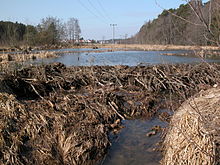
Beaver dam at the Buxbach near Veitserlbach

Mixed mountain forest in autumn near Burgberg, Oberallgäu district
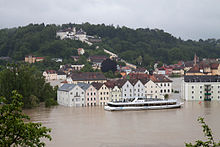
Passau at high water (2013)
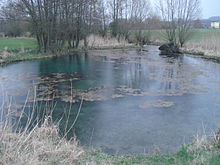
Bavaria's most beautiful geotopes: Gypsum karst spring bottomless hole
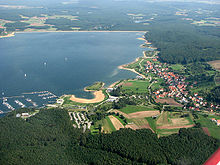
Aerial view of Lake Brombach from the west in the direction of the dam. On the right side of the picture Ramsberg and the ridge Schwarzleite can be seen.

Map of landscapes of Bavaria with rivers.
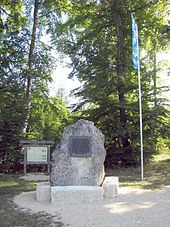
Kipfenberg: Geographical center of Bavaria

Wörth an der Donau: transition of the Danube plain (Gäuboden, Dungau), right - to the Bavarian Forest, left
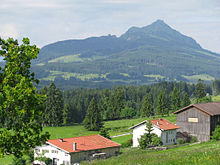
The Grünten, "Guardian of the Allgäu
.jpg)
Landscape in the Bavarian Alps: Ramsau near Berchtesgaden, the Reiteralpe in the background
History
→ Main article: History of Bavaria
→ Main article: History of Franconia
→ Main article: Swabia
Ancient
→ Main article: Bavarians
From the 3rd century BC, Celtic tribes founded the first fortified, city-like settlements in the foothills of the Alps. In the oppidum of Manching, about 5,000 to 10,000 Celts already lived within a city fortification at that time. At the time of Emperor Augustus, the Celtic-populated area of Old Bavaria south of the Danube became part of the Roman Empire and its provinces of Raetia and Noricum. After the collapse of Roman rule, the people of the Bavarians formed. Presumably, the Bavarians formed from different ethnic groups:
- from remnants of the Celtic population (Vindelics, Boians)
- from native romans
- from Alemannic, Frankish resp. Thuringian, Ostrogothic and Longobardic folk splinters
- from Germanic mercenaries of the Roman frontier troops
It is assumed that the Bavarians formed a tribe in their own country, i.e. the land between the Danube and the Alps.
Elder tribal duchy
→ Main article: Tribal Duchy of Bavaria
For the year 555 AD, the existence of a Bavarian tribal duchy with its seat in Freising and Regensburg under the Agilolfingers is documented, which became part of the Frankish dominion of Austrasia under the Merovingians. With the Lex Baiuvariorum, the first codified Bavarian tribal law came into being (around 741/743). Charlemagne's victory over the Bavarian Duke Tassilo III in 788 marked the end of the so-called older tribal duchy. From 788 until the beginning of the 10th century there was no Bavarian duke. The Carolingians ruled as Bavarian kings or sub-kings and sometimes appointed governors (prefects) to exercise their rule.
Younger tribal duchy
The decline of the Carolingians allowed a revival of the independence of the Bavarian dukes in the so-called younger tribal duchy. After the end of the Carolingian period of rule, the independence of the individual territories gradually strengthened again. This was supported by the threat from outside by the Hungarian invasions from about 862 on. Margrave Luitpold of Bavaria fell in a defeat against the Hungarians in the Battle of Pressburg in 907, but the date is seen at the same time as the beginning of the younger Bavarian tribal duchy by the accession of his son Arnulf I as Duke of Bavaria. After the victory in the Battle of Lechfeld, a second wave of Bavarian eastern settlement followed, with gains of territories in present-day Lower Austria, Istria and Carniola. The dispute with the Ottonians again led to a strong dependence on the German royalty. In 976, the southeast of Bavaria was separated as part of a newly created duchy of Carinthia. In addition, the Babenberg dynasty ruled in the Marcha Orientalis (Eastern Arrichi) increasingly independent of the Bavarian duke. In 1014, Duke Henry IV of the Bavarian line of the Ottonians became Roman-German emperor as Henry II.
From 1070 onward, the power of the Bavarian dukes was reasserted under the Guelphs. In 1156, the Margraviate of Austria was detached and elevated to a duchy itself under the Babenbergs, who had previously ruled all of Bavaria for a short time. In 1180, at the instigation of the princes, Frederick I Barbarossa overthrew the Guelph Henry the Lion, Duke of Bavaria and Saxony. The Duchy of Bavaria was further reduced by the secession of Styria and the andechs margraviate of Istria. The Counts of Tyrol also acted increasingly independently of the Bavarian duke and, like the Wittelsbach dynasty, later benefited from the extinction of the Counts of Andechs, who had last also possessed the duchy of Merania, which had been separated from Bavaria.
Territorial Duchy
→ Main article: Duchy of Bavaria (HRR)
From 1180, the diminished Bavaria was ruled as a territorial duchy by the Wittelsbach dynasty, which remained in power until the end of the monarchy in 1918. In 1214, the Palatinate also fell from the Guelphs to the Wittelsbachs. The ducal suburb had shifted several times during this period, first from Regensburg to Kelheim until 1231 and then to Landshut until 1255.
Bavaria experienced a period of numerous divisions into individual duchies from 1255 to 1503. Shortly before the first reunification, Ludwig IV became the first Wittelsbach to attain the imperial dignity in 1328, which meant a new peak of power for Bavaria. At the same time, however, the archdiocese of Salzburg finally broke away from the motherland of Bavaria. In the House Treaty of Pavia of 1329, Ludwig divided the property into a Palatine line with the Rhine Palatinate and what was later called the Upper Palatinate and an old Bavarian line. The newly acquired territories of Brandenburg, Tyrol, the Dutch provinces of Holland, Zeeland and Friesland, and Hainaut were very soon lost again under his successors. Tyrol fell to the Habsburgs in 1363, Brandenburg to the Luxembourgs in 1373. With the Golden Bull in 1356, the electoral dignity for the old Bavarian line was lost to that of the Palatinate.
In 1429, after the extinction of the Straubing-Holland line, the Duchy of Bavaria-Straubing was divided among the Munich, Ingolstadt and Landshut lines. In 1447, Bavaria-Ingolstadt fell to Bavaria-Landshut, which in turn was won by Bavaria-Munich in the Landshut War of Succession in 1503. The primogeniture law of Duke Albrecht IV of 1506 put an end to the division of the lands. The Free Imperial Cities of Nuremberg and Augsburg, which border on Bavaria, were important centers of trade and commerce from the beginning of the modern era until the end of the Renaissance, which in Augsburg was mainly due to the influence of the Fugger and Welser merchant families. During this period, both towns, together with Cologne and Prague, were among the four largest cities of the Holy Roman Empire and had caught up with Regensburg, which was also a Free Imperial City.
Electorate
→ Main article: Electorate of Bavaria
Bavaria took a leading position in the Counter-Reformation and emerged from the Thirty Years' War with territorial gains and the rise to an electorate: in 1620, the troops of the Catholic League led by the Bavarian commander Tilly defeated the Protestants in the Battle of the White Mountains near Prague. Afterwards, Tilly had the Palatinate occupied. In return, Maximilian I received the electoral dignity in 1623 and the Upper Palatinate, which he had occupied, as war reparations in 1628. After the war, Elector Ferdinand Maria devoted himself to rebuilding the devastated land and pursued a cautious policy of neutrality.
During the Spanish and Austrian Wars of Succession and in the course of the great power policy of Maximilian II. Emanuel and later his son Karl Albrecht, absolutist Bavaria was twice temporarily occupied by Austria. In 1705, the Bavarian people rose up against the imperial occupation. The Bavarian popular uprising covered large areas of Lower Bavaria, the Innviertel and eastern Upper Bavaria. A state defiance congress met in December 1705 in Braunau am Inn, which was still Bavarian at the time. It was not until the Battle of Aidenbach on January 8, 1706 that the popular uprising was completely defeated. After Karl Albrecht's coronation as emperor, large parts of the Electorate were reoccupied until 1744. Karl Albrecht's son Maximilian III Joseph finally ended the great power policy of his predecessors in 1745 and devoted himself to internal reforms.
After the extinction of the old Bavarian line of the Wittelsbachers, the dual Electorate of Electoral Palatinate-Bavaria was created in 1777 under the regency of Elector Karl Theodor from the Palatine line of the Wittelsbachers. Count Rumford began further reforms under Karl Theodor, including in the Bavarian Army.
Kingdom
→ Main article: Kingdom of Bavaria
At the time of Napoleon, Bavaria was initially on the side of France and was able to record large territorial gains through secularization and mediatization. Salzburg, Tyrol, Vorarlberg and the Innviertel region, which had been lost in 1779, temporarily fell to Bavaria. In the Peace of Pressburg, concluded between France and the German Emperor Franz II on December 26, 1805, Bavaria, allied with Napoleon, was proclaimed a kingdom. King Max I Joseph's minister Maximilian Count von Montgelas is considered the creator of the modern Bavarian state. The new kingdom eliminated all relics of serfdom left by the old empire. The religious edict of 1803 gave equal rights to all three Christian confessions - Catholics, Reformed and Lutherans. In 1807, the tax privileges of the estates were abolished. In 1805, all hereditary and venal offices were abolished by the great service pragmatism. The Munich Regulativ of 1805 and the Juden-Edikt of 1813 granted the first freedoms to Israelites in the new Bavaria. On August 27, 1807, Bavaria became the first country in the world to introduce smallpox vaccination. In 1812, the Bavarian Gendarmerie was founded. A new penal code drafted by Anselm von Feuerbach abolished torture in 1813. The principality of Ansbach fell to the Kingdom of Bavaria in 1806 through an exchange of territory forced by Napoleon, and the Protestant principality of Bayreuth was sold to Bavaria by Napoleon in 1810. By switching in time to the side of Napoleon's opponents in the Treaty of Ried, Bavaria was able to retain part of the territorial gains as the victorious power at the Congress of Vienna in 1814. It was compensated for the loss of Tyrol and the Palatinate on the right bank of the Rhine by economically more developed areas around Würzburg and Aschaffenburg. The newly created Rhine district on the left bank of the Rhine came to Bavaria in exchange for Salzburg in 1816 under the Treaty of Munich and was the Bavarian Rhine Palatinate from 1837.
King Ludwig I, who had ruled since 1825, developed the Bavarian capital Munich into a city of art and universities. He reintroduced censorship and eliminated freedom of the press. The Hambach Festival of 1832 in the Palatinate at Hambach Castle near Neustadt an der Weinstraße had its roots in the dissatisfaction of the Palatinate population with the Bavarian administration. Because of an affair with the dancer Lola Montez, he was forced to abdicate in 1848 in the wake of the March riots. Under his son and successor Max II. Joseph, there was a gradual liberalization but also the Palatine Uprising. The king was a supporter of the triad policy, which envisaged the development of the German middle states under the leadership of Bavaria into the third power alongside the two great powers Prussia and Austria.
In 1864 Ludwig II was proclaimed King of Bavaria. He went down in history as the fairy-tale king because of the construction of Neuschwanstein and other castles. In the German War of 1866, Bavaria suffered defeat at the side of Austria against Prussia. In 1868, the conservative, Greater German Patriotic Party (renamed the Bavarian Center in 1887) was founded.
In 1871, Bavaria became part of the newly founded German Empire, receiving so-called reserve rights (its own postal, railroad and army systems as well as its own diplomacy). In 1886, Prince Regent Luitpold took over the regency. Due to Luitpold's political passivity, the "Prince Regent period," as Prince Luitpold's era is often referred to, is regarded as an era in which Bavarian interests gradually took a back seat to those of the Reich. In 1893, the SPD entered the Bavarian state parliament for the first time, and in 1906, the state election law was aligned with the imperial election law. Ludwig III became king in 1913, and World War I broke out the following year. Still on November 2, 1918, there was a reform of electoral law and parliament. However, the Wittelsbach monarchy was deposed shortly thereafter as part of the November Revolution of 1918.
See also: Social and economic history of Bavaria during the First World War
Free State (Bamberg Constitution)
In the course of the November Revolution, on November 8, 1918, Kurt Eisner, writer and journalist, founding member of the USPD, proclaimed Bavaria a people's state or Free State, the Free People's State of Bavaria. Following the Basic Law of the Republic of Bavaria of January 4, 1919, the Bamberg Constitution of August 14, 1919, became Bavaria's first democratic constitution and ended the Kingdom of Bavaria, founded in 1806. (In the meantime, however, socialist groups were still able to install the "Munich Council Republic" for four weeks starting on April 7, 1919).
As a result of a referendum, the Free State of Coburg became part of Bavaria on July 1, 1920 (→ Coburg district). Due to the provisions of the Treaty of Versailles, the district office of St. Ingbert and parts of the district offices of Homburg and Zweibrücken had to be ceded to the newly created Saar region, which was under the administration of the League of Nations, on January 10, 1920. It was not until 1930 that the French occupation was withdrawn and the Palatinate was completely reassigned to Bavaria.
As a stronghold of ultra-conservative and reactionary forces, Bavaria was referred to as a "cell of order" in the early years of the Weimar Republic. On November 8 and 9, 1923, Bavaria became the scene of the Hitler putsch, but the Bavarian state police were able to put it down. The strongest party was the Bavarian People's Party, which usually also provided the minister president.
Loss of sovereignty (National Socialism, World War II)
As an administrative unit, Bavaria continued to exist during the period of National Socialism (1933 to 1945), but was largely insignificant. The city of Munich, however, where Adolf Hitler had lived for a long time since 1913 and had begun his political rise, was stylized by the National Socialists for propaganda purposes as the capital of the movement. With the Dachau concentration camp, the Nazi regime established the first continuously operated concentration camp only a few weeks after the so-called seizure of power. In Nuremberg, Franconia, the NSDAP held its party rallies and other propaganda events on the Reich Party Rally Grounds from 1933 to 1938. In 1935, the Nuremberg Laws came into force. On the Obersalzberg near Berchtesgaden, Hitler had the Berghof built, which served as his second seat of government and developed into a central place of power in the National Socialist German Reich. In 1939, the government district of Lower Bavaria-Upper Palatinate was expanded to include an area that had belonged to Czechoslovakia until the Munich Agreement in 1938, the districts of Bergreichenstein, Markt Eisenstein and Prachatitz, which was separated again in 1945.
See also: History of Bavaria between the World Wars
During World War II, Bavarian cities such as Aschaffenburg, Augsburg, Munich, Nuremberg and Würzburg suffered heavy destruction (see Air Raids on Aschaffenburg, Augsburg, Munich, Nuremberg and Würzburg).
Restoration as a state after 1945 (part of the American occupation zone)
The occupying powers deliberately channeled displaced persons from Silesia and the Sudetenland into sparsely populated Bavaria. As a result, the population grew by a quarter by 1949. Several cities for displaced persons were established.
General Eisenhower officially restored Bavaria as a state with Proclamation Number 2 of September 28, 1945; executive power was in the hands of U.S. military governors between 1945 and 1952. After occupation by U.S. troops, Bavaria became part of the American occupation zone, while in 1946 the heavily industrialized Rhineland-Palatinate, located in the French occupation zone, was incorporated into the newly formed state of Rhineland-Palatinate.
Since the U.S. military government was firmly opposed to the restoration of a monarchy, it banned the re-established Bavarian Home and Royal Party in 1946. (After the end of the military government in 1949, however, the party could be reconstituted).
Free State (within the Federal Republic of Germany)
A constituent assembly met in Munich from June 30, 1946. A new, republican constitution of the Free State of Bavaria was adopted by a large majority of the people in 1946 (for more details, see the article Bavarian Constitutional History).
In 1948, at the request of the state government, the state parliament decided to reject the Basic Law but to recognize it as binding if two-thirds of the states accepted it. In 1949, Bavaria became part of the Federal Republic of Germany as a state on this basis. The reincorporation of the Lindau district into Bavaria took place on September 1, 1955. A long-lasting economic upswing ("economic miracle") contributed to Bavaria not only remaining an agricultural state, but becoming home to many industrial companies. From 1962 to 2008 and from 2013 to 2018, the CSU held an absolute majority in Bavaria. In 1987, Bavaria changed for the first time from a recipient state to a donor state in the fiscal equalization system and has been the largest donor state without interruption since 2008.
See also: History of Bavaria after 1945

King Ludwig II in general uniform with the coronation mantle
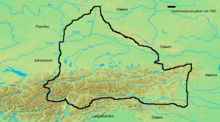
The Bavarian Tribal Duchy in the 8th Century
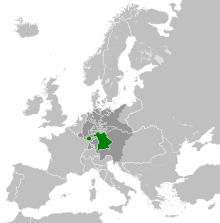
Kingdom of Bavaria 1816 after the Treaty of Munich

Great coat of arms of the Kingdom of Bavaria
Population
See also: Bavarian citizenship
Around 13 million inhabitants or 16 percent of the German population live in the Free State of Bavaria. After North Rhine-Westphalia, Bavaria is the most populous subnational entity in the European Union and one of the more populous constituent states in the Western world.
Bavaria's population is growing. Since 1840, Bavaria's population has more than tripled. The 1970 census was the first to count more than 10 million inhabitants. As of December 31, 2016, the population stood at 12,930,751, of which around 50.5% were female. Although more people die in the Free State than are born, due to significantly higher immigration compared to emigration, the population has increased continuously by a total of more than 400,000 since 2012. At the end of 2012, the proportion of foreigners corresponded to 9.6 percent. Bavaria had a total fertility rate of 1.55 children per woman in 2017, slightly below the national average of 1.57.
| Population development of the Free State of Bavaria | |||||||||||||||||||||||||||||||||||||||||||||||||||||||||||||||||||
| |||||||||||||||||||||||||||||||||||||||||||||||||||||||||||||||||||
As in the whole of (West) Germany, there was immigration from the 1950s onwards against the background of the German economic miracle, especially from Turkey, the former Yugoslavia and Italy, and increasingly around 1990 after the end of the Cold War from East Central European and East European countries.
"Four Tribes of Bavaria"
At the beginning of 1778, the Electorate of Bavaria and the Electoral Palatinate were reunited by succession of the Wittelsbach dynasty. While in Napoleonic times the Palatinate on the right bank of the Rhine came to Baden, large parts of the Palatinate on the left bank of the Rhine reverted to Bavaria in 1816 as the Rhine District. At the same time, Napoleon gave further Swabian areas and large parts of Franconia to the Kingdom of Bavaria. Until the Second World War, the four tribes of Bavaria were understood to be the Old Bavarians, Franconians, Swabians and Palatines. Numerous monuments from this period emphasize this fact.
After 1945, more than two million refugees and expellees, mainly the German Bohemians, German Moravians and Sudeten Silesians, known as Sudeten Germans, arrived in Bavaria. The Sudeten Germans were referred to by Franz Josef Strauß as the "fourth tribe," with the German Bohemian, German Moravian and Sudeten Silesian populations coming from different dialectal and cultural areas of the German-speaking region within what was then Czechoslovakia, making them heterogeneous. Sinti and Jenische also have a long tradition in Bavaria that has not yet been recognized by the state.
Since World War II and the final loss of the Rhenish Palatinate in 1946, Bavaria's original resident population and the German-Bohemian population that immigrated immediately after World War II have now been subdivided into "Four Tribes" (see German Tribes for the origin of the word) and are composed of the three traditionally resident tribes, the Franks, the Swabians, and the Old Bavarians who gave their name to the Free State, as well as, as the fourth tribe, the Sudeten Germans, for whom Bavaria assumed "patronage."
Distinguishing features of the three originally resident tribes are, for example, their own dialects (Bavarian, East Franconian, Alemannic), their own cuisines (Bavarian, Franconian, Swabian), their own traditions, traditional costumes and, in some cases, architectural styles. Occasionally, even different mentalities are attributed to the individual tribes; for example, according to the Bavarian state government, the Old Bavarians are cosmopolitan, persistent and musically gifted, while Franconians are characterized by a pronounced "sense of community, organizational talent, cheerfulness and a quick grasp of things," while Swabians are seen as thrifty people who have a "tendency to understatement." In cabinet formations, offices are distributed according to the tribes for reasons of proportional representation. The three CSU ministerial posts in Merkel III's federal cabinet were also distributed among the three tribes of Franconia, Bavaria and Swabia.
The long dispute between the Franconians and the Old Bavarians about the alleged unequal treatment of the Franconians by the Bavarians is particularly well known. According to some organizations, Franconia is underrepresented in the party structures and receives less tax money. Also generally less one worries about interests and problems of the Franconian administrative districts. Occasionally, the return of so-called looted art, works of art from Franconian cities and treasuries that were confiscated by the Kingdom of Bavaria in the 19th century and brought to Munich, is also demanded. However, many such complaints are considered to be without merit. For example, Franconian politicians are not underrepresented in the structures of the major parties. The demand for the return of art treasures is also problematic, since, for example, the Hofer Altar in Munich and some Dürer paintings in the Alte Pinakothek were not looted but voluntarily given away.
Religion and worldview
| Denominational affiliations of the Bavarian population (in percent) | |||||||||||
| 1840 * | 1900 * | 1933 * | 1950 | 1970 | 2006 | 2011 | 2015 | 2016 | 2018 | 2019 | |
| Roman Catholic | 71,1 | 70,5 | 70,0 | 71,9 | 70,4 | 57,2 | 55,0 | 51,2 | 50,5 | 48,8 | 47,8 |
| evangelical | 27,4 | 28,3 | 28,7 | 26,5 | 25,2 | 21,3 | 21,0 | 18,9 | 18,8 | 17,8 | 17,6 |
| muslim | - – | - – | - – | - – | 00,9 | 02,2 | 4, | - | - | - | - |
| christian-orthodox | - – | - – | - – | - – | - – | - – | 01,6 | - | - | - | - |
| jewish | 01,4 | 00,9 | 00,5 | 00,1 | 00,1 | 00,1 | 00,1 | - | - | - | - |
| other denominationsand non-denominations | 00,1 | 00,3 | 00,8 | 01,5 | 03,4 | 19,2 | 18,3 | - | 31,2 | 33,4 | 34,6 |
| * including the Palatinate region | |||||||||||
With 47.8% (as of 2019), Bavaria is the state with the highest Roman Catholic population share in Germany after Saarland. Another 17.6% of the population is Evangelical Lutheran. These two denominations are unevenly distributed across the districts. Thus, Old Bavaria and Lower Franconia are predominantly Catholic, while Middle Franconia and parts of Upper Franconia are Protestant.
The number of Catholics and Protestants has decreased significantly since 1970. Both the margraviate of Ansbach and Bayreuth and the majority of the free imperial cities (such as Nuremberg or Rothenburg ob der Tauber) belonged to the Lutheran heartland and were strongholds of the Reformation.
The Bavarian state pays the Roman Catholic Church 65 million euros and the Protestant Church 21 million euros in state endowments annually from the general budget. The Catholic parishes belong to the diocese of Würzburg, the diocese of Eichstätt and the archdiocese of Bamberg in the ecclesiastical province of Bamberg, as well as the diocese of Regensburg, the diocese of Passau, the diocese of Augsburg and the archdiocese of Munich and Freising in the ecclesiastical province of Munich and Freising. Other Catholic parishes are under the jurisdiction of Eastern Catholic Churches.
The Evangelical Lutheran Church in Bavaria is a member church of the Evangelical Church in Germany (EKD) and is divided into six church districts of Ansbach-Würzburg, Augsburg, Bayreuth, Munich, Nuremberg and Regensburg. The EKD also includes the ten Bavarian congregations of the Evangelical Reformed Church.
Protestant free churches are found primarily in metropolitan areas. The Old Catholic Church has a Bavarian deanery.
Until the 19th century, Jewish communities existed mainly in rural areas of Franconia and Swabia as well as in the free imperial cities such as Nuremberg (settlement ban from 1499 to 1850) and Regensburg. In Wittelsbachian Old Bavaria there were virtually no Jews, but since the Jewish Emancipation there have been increasing numbers in Bavarian cities. From almost 200 Jewish communities before the Holocaust, 13 communities still exist in Bavaria, or exist again. They are organized in the IKG Munich and Upper Bavaria and in the Landesverband der Israelitischen Kultusgemeinden in Bayern.
Islam is of growing importance, especially in large cities. Many mosque communities are trying to replace their previous backyard mosques with representative new buildings. A study by the Federal Ministry of the Interior puts the proportion of Muslims in the total Bavarian population in 2008 at around 4 percent (about 13 percent of Muslims living in Germany).
As in many areas of Germany, the proportion of non-denominational residents is also growing in Bavaria. The Humanist Association sees itself as a worldview community and advocacy group for non-religious people. The association, which had reported around 2100 members in March 2019, is in Bavaria, among other things, the carrier of the Humanistische Lebenskundeunterricht, it operates since 2008 an elementary school in free sponsorship and over a dozen day care centers. It maintains its own social work and the Tower of the Senses in Nuremberg.
Especially in urban centers, there are smaller Buddhist, Alevi, Hindu and Bahai congregations, Kingdom Halls of Jehovah's Witnesses and congregations of smaller Christian churches such as the Seventh-day Adventists. In Munich, the almost extinct religious community of the Mandaeans has found refuge and established a congregation. Due to the conflict with the German state over compulsory education, the Twelve Tribes near Nördlingen made negative headlines. Since 1966, Bavaria has also had a now large Assyrian-Aramaic community, most of which belongs to the Syriac Orthodox Church of Antioch. Most of these Suryoye come from the limestone mountains of Tur Abdin, located in southeastern Turkey.
Most populous cities
| Most populous cities in the Free State of Bavaria (large medium-sized cities with more than 50,000 inhabitants) | ||||
| Rank | City | Inhabitants on31 | Inhabitants on31 | Change2000-2020in |
| 01. | Munich | 1.210.223 | 1.488.202 | +23.0 |
| 02. | Nuremberg | 0.488.400 | 0.515.543 | +5.6 |
| 03. | Augsburg | 0.254.982 | 0.295.830 | +16.0 |
| 04. | Regensburg | 0.125.676 | 0.152.270 | +21.2 |
| 05. | Ingolstadt | 0.115.722 | 0.136.952 | +18.3 |
| 06. | Fürth | 0.110.477 | 0.128.223 | +16.1 |
| 07. | Würzburg | 0.127.966 | 0.126.954 | -0.8 |
| 08. | Erlangen | 0.100.778 | 0.112.385 | +11.5 |
| 09. | Bamberg | 0.069.036 | 0.076.674 | +11.1 |
| 10. | Bayreuth | 0.074.153 | 0.074.048 | -0.1 |
| 11. | Landshut | 0.058.746 | 0.073.065 | +24.4 |
| 12. | Aschaffenburg | 0.067.592 | 0.070.858 | +4.8 |
| 13. | Kempten (Allgäu) | 0.061.389 | 0.068.940 | +12.3 |
| 14. | Rosenheim | 0.058.908 | 0.063.591 | +7.9 |
| 15. | Neu-Ulm | 0.050.188 | 0.058.841 | +17.2 |
| 16. | Schweinfurt | 0.054.325 | 0.053.319 | -1.9 |
| 17. | Passau | 0.050.536 | 0.052.415 | +3.7 |
| Note: All of the cities listed - except Neu-Ulm - are free of counties. | ||||
Bavaria's largest city and only city with over a million inhabitants is the state capital of Munich, with a population of around 1.45 million. It is the third-largest city in Germany and the eleventh-largest city in the European Union and is one of the Beta+ world cities. It is the largest city in Germany that is not a city-state. In addition, Munich is the most densely populated municipality in Germany, with about 4670 inhabitants per square kilometer (December 2015), as well as its highest major city, at 519 meters above sea level. Nuremberg, with its approximately 520,000 inhabitants, is the second largest city in the country, occupies the 14th place nationwide as well as the 51st place in the European Union and is one of the world cities of the Gamma- category. Due to the importance of Nuremberg, Munich does not represent a primary city in Bavaria. Augsburg, with a population of nearly 300,000, is the third-largest city in the state and ranks 23rd nationally. There are a total of eight major cities in Bavaria. Bavaria's youngest major city (population at least 100,000) is Fürth (since 1990), which was previously a major city from 1951 to 1956 and from 1972 to 1976. Together with Erlangen, Fürth and Schwabach, Nuremberg forms a distinct urban band with a population of around 800,000. Metropolitan regions in Bavaria are the Munich Metropolitan Region and the Nuremberg Metropolitan Region. Furthermore, parts belong to the Rhine-Main area.
Healthcare
There are over 400 hospitals in Bavaria, including five university hospitals. They have a total of around 73,000 beds and around 4,000 day-care facilities. About 60 percent of the hospitals are publicly owned. Bavaria also has over 3,200 pharmacies and around 60,000 physicians. The physician density is 208 inhabitants per physician, making Bavaria second only to Saarland in terms of population density. Nevertheless, there are warnings about the consequences of a shortage of doctors in Bavaria, especially in rural areas and among specialists. Most residents of Bavaria have health insurance with AOK Bayern.
The average life expectancy in 2015/17 was 79.13 years for men and 83.63 years for women. Men thus rank 2nd among the German states, while women rank 3rd. Regionally, Starnberg (expectation of total population: 83.39 years), Munich (city) (83.02) and the district of Munich (82.97) had the highest life expectancy in 2013/15, and Amberg (79.04), Straubing (78.80) and Hof (Saale) (78.75) the lowest.
Language and dialect
→ Main article: Dialects in Bavaria
The official language and lingua franca is German. Numerous other languages are spoken by those who come from other language regions or have the corresponding migration background.
In Bavaria, dialects of the Upper German dialect family dominate. In addition, Middle German dialects are spoken in narrowly defined areas.
The dialects in Bavaria can be assigned to the following dialect groups (from north to south):
Central German dialects:
- Rhine Franconian as South Hessian around Aschaffenburg (Lower Franconia)
- Thuringian Upper Saxon as Southeast Thuringian in Ludwigsstadt (Kronach County, Upper Franconia)
Upper German dialects:
- East Franconian as Main Franconian and Upper Franconian especially in the Franconian administrative districts
- Bairisch as North and Middle Bavarian, on the edge of Tyrol South Bavarian, especially in Old Bavaria
- Alemannic as Swabian and Lower Alemannic especially in the administrative district of Swabia
Between these dialect areas there are not to be underestimated transition areas, which cannot be assigned to one of these areas without a break. There are Bavarian-Franconian (for example Nuremberg and surroundings), Bavarian-Swabian (among others Lechrain) and Swabian-Franconian (area around Dinkelsbühl and Hesselberg area) transitional areas, in some places even Bavarian-Swabian-Franconian mixed dialects (for example Treuchtlingen, Eichstätt).
The dialects are very common among the locals, especially outside the big cities, although in metropolitan areas like Munich there is an extinction of dialects.
The Bavarian dialects are lexicographically recorded by the Bavarian dictionary, the Swabian dialects by the Swabian dictionary and the East Franconian dialects by the Franconian dictionary, to which are added numerous dictionaries on local and regional dialects. Areallinguistically, the dialects of Bavaria are processed by the Language Atlas of Bavarian Swabia, the Language Atlas of Middle Franconia, the Language Atlas of Lower Bavaria, the Language Atlas of Northeast Bavaria, the Language Atlas of Upper Bavaria and the Language Atlas of Lower Franconia.
Numerous other German and non-German dialects are spoken by those who come from other dialect or language regions.
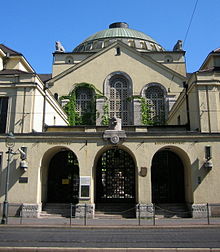
Entrance to Augsburg Synagogue
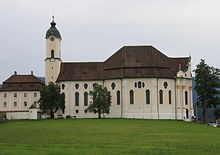
Wieskirche in Upper Bavaria

Maxmonument in Munich; the putti at the feet of King Maximilian II hold shields with the coats of arms of the provinces of Old Bavaria, Palatinate, Franconia and Swabia
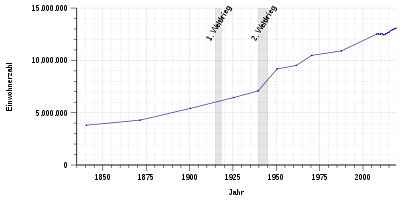
Population development of Bavaria from 1840 to 2018 according to the adjacent table

Population pyramid for Bavaria (data source: Census 2011)
Politics
→ Main article: Bavarian political system
State structure
The basis of politics in Bavaria is the Constitution of the Free State of Bavaria, adopted by referendum on December 1, 1946. The constitution came into force on December 8, 1946. Bavaria is thus a free state (republic) and a people's state (democracy). Since January 1, 2000, a unicameral parliamentary system has existed following the abolition of the Senate.
Legislative power lies with the Bavarian Parliament, whose members are elected every five years (until 1998: every four years). Until the end of 1999, a second chamber, the Senate, existed to provide representatives of social and economic interest groups with a political counterweight to the Landtag. A referendum on February 8, 1998, decided to abolish this chamber. Until then, Bavaria was the only German state with a second chamber. However, it had only limited influence because it was not allowed to introduce legislation, but only had the right to participate.
The state government is headed by the Bavarian Minister President. He directs business, sets policy guidelines, represents Bavaria to the outside world and appoints the state ministers and secretaries.
Apart from the Landtag, laws and amendments to the constitution in Bavaria can be passed by popular initiative and referendum. A referendum is mandatory for any amendment to the Bavarian constitution.
See also: Bavarian Minister President and Legislative Process in Bavaria
Legislative
→ Main articles: Bavarian state parliament, state parliament elections in Bavaria and Bavarian state parliament election system
The Bavarian State Parliament is the state parliament of the Free State of Bavaria. Its seat is the Maximilianeum in Munich. A legislative period lasts five years. Six parties are currently represented in the Bavarian State Parliament. After the election of October 14, 2018, the following distribution of seats and vote shares resulted (a total of 205 seats):
| Election to the Bavarian State Parliament on October 14, 2018 | |||
| Party | Share of votesin | Seats | Change compared to2013 |
| Christian Social Union in Bavaria (CSU) | 37,2 | 85 | −10,5 |
| Bündnis 90/Die Grünen (Green Party) | 17,6 | 38 | 0+9,0 |
| Free voters (FW) | 11,6 | 27 | 0+2,6 |
| Alternative for Germany (AfD)* | 10,2 | 22 | +10,2 |
| Social Democratic Party of Germany (SPD) | 09,7 | 22 | −10,9 |
| Free Democratic Party of Germany (FDP) | 05,1 | 11 | 0+1,8 |
| The Left (Left) | 03,2 | - – | 0+1,1 |
| Bavarian Party (BP) | 01,7 | - – | 0−0,4 |
| Ecological Democratic Party (ÖDP) | 01,6 | - – | 0−0,4 |
| Other | 02,2 | - – | 0−2,4 |
*2013 not competed
Executive
→ Main article: Bavarian state government
The State Government is the supreme authority of the Free State of Bavaria. The Minister President, elected by the Landtag, appoints and dismisses the Ministers of State and the Secretaries of State with the approval of the Landtag. He assigns the Ministers of State a portfolio or a special task, which they administer on their own responsibility in accordance with the departmental principle and the policy guidelines determined by the Minister President (guideline competence). The state secretaries are bound by instructions to their state ministers. The Bavarian State Chancellery supports the Minister President and the State Government in their constitutional duties. The constitutional maximum limit of 18 members in the cabinet of the state government is usually fully utilized.
Judiciary
→ Main article: List of courts of the Free State of Bavaria
The highest Bavarian court is the Bavarian Constitutional Court. There are also various higher regional courts, including three higher regional courts in Munich, Nuremberg and Bamberg, the Bavarian Administrative Court, two regional labor courts (Munich and Nuremberg), the Bavarian Regional Social Court and the rest of the judiciary. The Bavarian Supreme Court as the highest Bavarian court of ordinary jurisdiction was dissolved effective July 1, 2006, and re-established as of September 15, 2018, but with fewer powers.
Right to vote
Compared to elections at the federal level, Bavarian electoral law has several special features: Direct candidates who have won the election in their constituency can only enter the state parliament if their party has also reached the five percent threshold.
Furthermore, the distribution of seats in the state parliament results from the sum of the first and second votes. In other federal states and in federal elections, the first vote determines the election of the direct candidate in the electoral district and the second vote alone determines the number of seats in parliament, which usually results in first votes being given more frequently to the major parties with promising direct candidates. Thus, those who vote for a smaller party with both votes in a Bavarian state election do not give away their first vote, since both votes go to that party, even if the corresponding constituency candidate does not make it into the state parliament. In addition, the second vote can be given to a specific candidate of a party, so that the ranking of the candidates can change compared to the lists drawn up by the parties.
Another special feature is found in the municipal election law. There is the possibility of cumulating (up to three votes can be cast for a single candidate) and of panicking (votes can be distributed among candidates on different lists).
See also: List of electoral and voting districts in Bavaria and constituency (Bavaria)
Direct democracy
→ Main article: Direct democracy in Bavaria and popular legislation in Bavaria
There are numerous direct democratic elements in Bavaria. In addition to referendum petitions and referendums at the state level, direct democracy was introduced at the local level by a referendum on October 1, 1995. Although the Bavarian Constitutional Court tightened the regulations in 1997 (among other things by introducing a voting quorum), Bavarians still initiate around 100 referendums every year.
County councils and mayors
In local elections, the three largest forces are usually the CSU, SPD and Free Voters. Of the 71 district councils, 50 are held by the CSU, 6 by the SPD, 13 by the Free Voters and two by the Greens; five district councils are female. Of the mayors of the 25 independent cities, eleven are held by the CSU and eleven by the SPD, including in Nuremberg (Marcus König) and Munich (Dieter Reiter). In addition, one CDU member, one independent and one candidate from the Bayreuth Community Voters' Association have each been elected to office. The last Bavarian municipal election was held on March 15, 2020.
See also: Municipal Election Law (Bavaria) and Mayor#Bavaria
Party landscape
The party landscape in the Free State of Bavaria has characteristics that are not present in the rest of the Federal Republic: the CDU, as the people's party, is not represented with its own state association and does not participate in elections. Instead, it gives way to the CSU as a sister party. Another unusual feature for a German state is that the CSU has held the office of prime minister without interruption since 1957, often in conjunction with an absolute majority in the state parliament.
The SPD has one of the lowest approval ratings of all SPD state associations in Bavaria. It was the largest opposition party with one-fifth to one-third of the vote in state elections until the 2018 state election in Bavaria. In this election, it achieved just under 10%, making it the fifth strongest party after the CSU, the Greens (17.5%), the Free Voters and the AfD. By contrast, in the past the Bavarian Greens always entered parliament with just under ten percent of the vote. In the last state election, they won six direct mandates for the first time. In contrast to other federal states and the federal level, the Free Voters regularly enter the state parliament in Bavaria, while Die Linke, the Pirate Party and the FDP hardly play a role politically and have rarely or never been elected to the state parliament. The AfD managed to enter the new Bavarian state parliament in 2018, when it stood for election for the first time.
Several regional parties are active in Bavaria. The Bavarian Party, for example, advocates the possibility of a referendum on Bavaria's withdrawal from the German state. While it entered the state and federal parliaments in the 1950s and 1960s and participated in the state government from 1962 to 1966, this party completely lost importance after leaving the state parliament. In 2009, the Party for Franconia was founded in Bamberg, a regional small party that, among other things, advocates better economic equality for Franconia within the Free State. With the exception of the 2014 local elections, this party has not yet had any particular electoral successes.
Partnerships and sponsorships
On June 5, 1954, the Free State of Bavaria and the Bavarian State Government under Hans Ehard took over the sponsorship for the Sudeten German ethnic group who moved to the Federal Republic after the expulsion of the Germans from Czechoslovakia.
The Free State of Bavaria maintains contacts with the following partner regions:
- since 1987: China People's Republic of
 Shandong, People's Republic of China
Shandong, People's Republic of China - since 1989: Canada
 Québec, Canada
Québec, Canada - since 1995: Sud Africa
 Western Cape, South Africa
Western Cape, South Africa - since 1995:
 Sud Africa Gauteng, South Africa
Sud Africa Gauteng, South Africa - since 1997: Brazil
 São Paulo, Brazil
São Paulo, Brazil - since 2004: China People's Republic of
 Guangdong, People's Republic of China
Guangdong, People's Republic of China - since 2007: India
 Karnataka, India
Karnataka, India - Since 2007: United States
 Georgia, United States
Georgia, United States
Public debt
As at the federal level and in other German states, the public debt of the Free State of Bavaria developed upward over the long term. Debt has been repaid annually since 2011. In 1992, the debt was still around 15 billion; in 2010, a peak of 29 billion was reached. In 2016, the debt was 19 billion euros. at the end of 2018, 15 billion euros and at the end of 2019, 13 billion euros. In the medium term, the state government wants to pay off all debt by 2030.
Internal security
→ Main article: Bavarian police and list of correctional institutions in Bavaria
The Bavarian police force is the largest police force in the Federal Republic. In 2007, 666,807 crimes were statistically recorded in Bavaria. 428,766 cases (64.3 percent) were solved and 305,711 suspects were identified. This represents the highest clearance rate in Germany. With the Bavarian Police Helicopter Squadron, the Bavarian police also maintain the largest police helicopter squadron of any state police force.
Military
A Bavarian Army existed as a standing army from 1682 until its dissolution in 1919. The Bavarian Reichswehr had a certain independence until 1924. At present, the Bundeswehr has around 60 locations in Bavaria with a total of 50,700 service posts. In the course of the realignment of the Bundeswehr, three locations are closing in Bavaria and the number of service posts is falling to 31,000. The largest barracks in Bavaria is the Hochstaufen Barracks in Bad Reichenhall.
Bundeswehr technical schools are located in Munich and Würzburg. The 10th Armored Division of the Bundeswehr, which was created from the Southern Division, is located in Veitshöchheim. The Bundeswehr Medical Academy, the Southern Military Service Court and the University of the Bundeswehr are located in Munich, and the Defense Science Institute for Materials and Supplies in Erding. Bavaria's highest command authority is the Bavarian State Command. There are over 150,000 reservists organized in associations in the Free State.
There are several U.S. military bases in Bavaria. The third largest military training area in Europe is the Grafenwoehr military training area.
The mountain riflemen, who were once responsible for national defense, now generally perform only representative duties; for example, at the request of the state government, they form an honorary formation during official visits to Bavaria by foreign heads of state.
Bavaria in Europe
The State Minister for European Affairs and International Affairs, Melanie Huml, is entrusted with liaising with European politics and administration. The Bavarian State Chancellery has a representation at the European Union in Brussels.
Bavaria has many relations and cooperations with the European neighboring states, among others for the coordination of the Alps and Danube policy. The Free State of Bavaria is represented by politicians in the Committee of the Regions. Twelve members of the European Parliament are from Bavaria: five from the CSU, three from the SPD, one each from Bündnis 90/Die Grünen, Freie Wähler, ÖDP and Linkspartei.
The Free State of Bavaria receives numerous subsidies from the EU, around 495 million euros from the European Regional Development Fund (ERDF) and almost 300 million euros from the European Social Fund (ESF), in each case in the 2014 to 2020 funding period.
Bavaria in the Confederation
In the Bundesrat, Bavaria has the highest possible number of six votes, as do Lower Saxony, Baden-Württemberg and North Rhine-Westphalia. Bavaria is represented by Minister President Markus Söder as well as Hubert Aiwanger, Florian Herrmann, Joachim Herrmann, Thorsten Glauber and Georg Eisenreich. The work in the Bundesrat is coordinated by the State of Bavaria's representation at the federal level. Florian Herrmann is responsible for federal affairs in the Bavarian cabinet as Minister of State for Federal Affairs and Media.
Consulates
The economic importance of Bavaria for the foreign trade of the Federal Republic of Germany as well as its significance as an important center of industry, trade and logistics, as the seat of foreign companies and with a population in which numerous different nationalities are represented, has led to 115 states being represented with their consulates (June 2015) on the territory of the Free State of Bavaria. Among them are 42 professional as well as 73 honorary consular representations. Most of the representations are located in Munich and its environs. There are also foreign representations in Nuremberg, Fürth and Regensburg. The doyen of the Bavarian Corps Consulaire is the Italian Consul General Filippo Scammacca Del Murgo.
Awards
The highest award bestowed by the Free State of Bavaria is the Bavarian Order of Maximilian for Science and Art, founded in 1853. The Bavarian Order of Merit, the Bavarian Constitutional Medal and numerous other orders, medals and decorations are awarded in recognition of outstanding service. On the recommendation of juries, the Free State awards numerous prizes, such as the Bavarian Film Prize and the Bavarian Print Prize.

The Bavarian flag at the Bavarian State Opera in Munich

The Order of Maximilian

Bavarian Representation in Berlin

Institute building of the Bavarian Representation to the EU (2010)
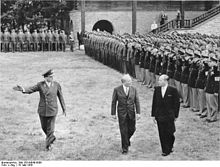
Wilhelm Hoegner and Theodor Blank attending an officers' training course in Sonthofen on May 15, 1956

Structure of the three-stage popular legislation procedure in the state of Bavaria
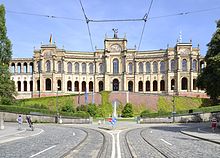
The Bavarian Parliament Building (Maximilianeum) in Munich
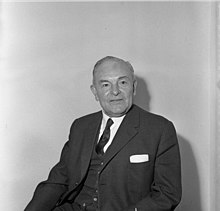
Hans Ehard, first elected Minister-President of Bavaria after the Second World War
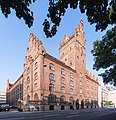
The Bavarian Constitutional Court is housed in the New Justice Building in Munich.

Bavarian State Chancellery, Munich (former Army Museum)
Sovereign symbols
→ Main article: Bavarian coat of arms, Bavarian state flag and Bavarian anthem
The Bavarian coat of arms consists of six heraldic components: The golden lion, originally associated with the Wittelsbach Palatinate on the Rhine, stands for the Upper Palatinate, the "Franconian rake" for the three Franconian districts, the blue panther for the Old Bavarians and the three black lions for Swabia. The white-blue heart shield indicates the state of Bavaria as a whole, the people's crown denotes the sovereignty of the people after the abolition of the royal crown. The small state coat of arms shows the Bavarian lozenges and the people's crown. The Bavarian lozenges and the Franconian rake serve as heraldic symbols.
The Free State of Bavaria has two equal state flags, the white-blue diamond-shaped flag and the flag with horizontal stripes in the colors white and blue. The lozenge flag always has a truncated white lozenge (also in the coat of arms) and at least 21 (truncated) lozenges in the upper left (heraldic right, upper corner) as seen from the viewer. The same white-blue lozenges are found in many city and county coats of arms in the areas of the historic Electoral Palatinate, since the Wittelsbach dynasty was also propertied in the Palatinate. A flag dispute exists over the Franconian flag.
The national anthem is the Bavarian Song. The original text comprises three stanzas and was written by Michael Öchsner, the melody was composed by Konrad Max Kunz. This historically correct text is still the official version (first two stanzas), is taught in schools and played at official and state events. The Bavarian Song (original version) has had anthem status of the Federal Republic of Germany since 1966.
Bavaria (the Latinized term for Bavaria) is the female symbol of Bavaria and appears as a personified allegory for the state of Bavaria in various forms and shapes. She thus represents the secular counterpart to Mary as the religious Patrona Bavariae. The Bavarian Lion is the symbolic figure of the Free State of Bavaria, including on monuments and awards. The state colors are white and blue.
See also: List of coats of arms in Bavaria
|
|
|
|
|
|
|
| Large national emblem | Small national emblem | State flag (diamond flag) | State flag (stripe flag) | State symbol "Free State of Bavaria | Coat of arms of Franconia |
Administration breakdown
→ Main article: Administrative division of Bavaria
Government districts and counties
The territory of the Free State of Bavaria is divided into administrative districts for general and internal administration, which are called Regierungsbezirke (districts according to the constitution). The Regierungsbezirke are headed by the governments, each of which is headed by a Regierungspräsident, who is appointed by the Minister of the Interior. The governments are the central authorities of the general and internal administration and are subordinate to the State Ministry of the Interior. Below are the Regierungsbezirke sorted according to the Amtlicher Gemeindeschlüssel (AGS) and with the abbreviations of the Bavarian State Ministry of the Interior.
In Bavaria, the districts of the same name are geographically congruent with the government districts. Unlike the Regierungsbezirke, which define the local jurisdiction of governments, the Bezirke are local authorities under public law. In Bavaria, the district is the third municipal level above the municipalities (first level) and counties (second level). They are self-governing bodies and therefore have democratically elected administrative bodies, the Bezirkstag, which is directly elected every five years by the eligible voters of the district, and a Bezirkstag president, who is elected from among the members of the Bezirkstag. Unlike the administrative districts, they can use coats of arms and flags like a municipality or a county.
See also: List of the administrative districts of Bavaria
| Government district | Government | Capital | AGS | Abbr. | Area in km² | Inhabitants | Inhabitants per |
| Upper Bavaria | Government of Upper Bavaria | Munich | 091 | OB | 17.529,10 | 4.719.716 | 269 |
| Lower Bavaria | Government of Lower Bavaria | Landshut | 092 | NB | 10.325,93 | 1.247.063 | 121 |
| Upper Palatinate | Government of the Upper Palatinate | Regensburg | 093 | OPf. | 09.690,12 | 1.112.267 | 115 |
| Upper Franconia | Government of Upper Franconia | Bayreuth | 094 | Ofr. | 07.231,12 | 1.062.085 | 147 |
| Middle Franconia | Government of Middle Franconia | Ansbach | 095 | Mfr. | 07.243,69 | 1.775.704 | 245 |
| Lower Franconia | Government of Lower Franconia | Würzburg | 096 | Ufr. | 08.530,08 | 1.317.507 | 154 |
| Swabia | Government of Swabia | Augsburg | 097 | Schw. | 09.991,54 | 1.905.841 | 191 |
| Free State of Bavaria | Bavarian state government | Munich | 090 | BY | 70.541,57 | 13.140.1830 | 186 |
· Coat of arms of the districts
· 
Upper Bavaria
· 
Lower Bavaria
· 
Upper Palatinate
· 
Upper Franconia
· 
Middle Franconia
· 
Lower Franconia
· 
Swabia
Planning regions
→ Main article: Planning regions in Bavaria
There are 18 planning regions in Bavaria. They are regional planning areas in which, according to the Bavarian State Development Program, balanced living and economic relationships are to be maintained or developed. To this end, a regional plan is drawn up for each region. The Donau-Iller region (15) is the first cross-state planning region in Germany with an eastern part in Bavaria and a western part in Baden-Württemberg.
| Lower Franconia:
Middle Franconia:
| Upper Franconia:
Upper Palatinate:
Lower Bavaria:
| Swabia:
Upper Bavaria:
|
Counties and independent cities
→ Main article: List of counties and independent cities in Bavaria, Counties in Bavaria and List of counties and district offices in Bavaria.
The seven administrative districts are divided into 71 counties and 25 independent cities. The counties and the independent cities are local authorities with the right to self-government. The administrative bodies of the counties are the county council and the district administrator. The independent city acts through the city council and the mayor. Both the district administrator and the lord mayor as well as the district council and the city council are elected by the eligible voters for a term of six years (southern German council constitution).
At the same time, the counties form districts, which determine the local jurisdiction of the sub-authorities of the general and internal administration. Unlike at the level of the administrative districts, however, the state has not set up its own internal authorities here, but uses the district administrator as an intermediary to perform the tasks of state administration; in this respect, the district administrator is the district administrative authority. In contrast, the independent cities are fully municipalized, since the tasks of the lower state administrative authority are transferred to them for independent execution.
The largest administrative district in Bavaria is Ansbach (Middle Franconia). The district of Munich (Upper Bavaria) is the most populous district in the Free State with around 330,000 inhabitants. Schwabach (Middle Franconia) is Bavaria's smallest independent city.
| The 71 counties of the Free State of Bavaria with license plates: | ||
| 1.
| 1.
|
| The 25 independent cities in Bavaria with license plates: | ||
| 1.
| 1.
|
Communities
→ Main article: List of cities and municipalities in Bavaria, List of markets in Bavaria, and List of areas in Bavaria not covered by municipalities.
→ Main article: "Bavaria" in the article List of district cities with special status in Germany.
The Free State of Bavaria consists of 2056 politically independent municipalities and 192 municipality-free areas, mostly lakes and forests (as of February 13, 2013). Of the 2031 municipalities belonging to the district, 985 are member municipalities in one of the 312 administrative communities (as of February 12, 2013).
The municipalities are distributed (as of February 12, 2013) among 25 independent cities and 29 large district cities. As of January 1, 2009, there were 262 other cities, 386 markets and 1355 other municipalities. In addition, 13 localities have been designated as high-performing county municipalities, which assume certain responsibilities for building supervision. While independent cities perform the same functions as counties, large county municipalities have only some functions beyond those of a "normal" county municipality. Although market law has no legal significance today, larger county municipalities can still be officially declared a "market" by the Bavarian state government upon their application. The term "market community" is not an official designation for a municipality in Bavaria. However, it does happen there that the term "market" is an official part of the municipality's name, for example Markt Berolzheim or Markt Einersheim.
The largest and most populous municipality in Bavaria is Munich, the smallest is Buckenhof in the Erlangen-Höchstadt district, and the least populous is Chiemsee in the Rosenheim district. Unterhaching is the most populous municipality in Bavaria without its own market or municipal law.
Administrative Reforms
The only county reform in Bavaria took place effective July 1, 1972. All other changes in county boundaries were due to smaller, non-fundamental reforms, which were mainly municipal area reforms. Sometimes municipalities were incorporated into existing municipalities, sometimes a new municipality was formed. From 1971 to 1980, as a result of municipality mergers, the efficiency of municipalities was greatly increased. The number of municipalities was reduced from about 7000 to about 2050, the number of counties decreased from 143 to 71, the number of independent cities decreased from 48 to 25. At the same time, the administrative unit of the large county seat was introduced.
See also: Territorial reform in Bavaria and district reforms in the Federal Republic of Germany until 1990#Bavaria

County-level cities and counties before territorial reform, 1970
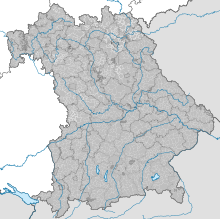
The Bavarian municipalities and counties. The areas without municipalities are marked in dark gray. Note: The few lakes shown (but not Lake Constance) are also municipality-free areas.

Imágenes principales Counties and independent cities in Bavaria
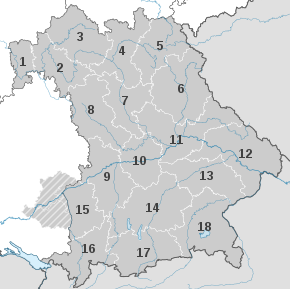
The planning regions
_-_de_-_colored.svg.png)
The Bavarian administrative districts, congruent with the counties of
Economy and transport
Bavaria is considered to be a very economically strong and wealthy state; it has developed from an agricultural to a technology location in recent decades. The gross domestic product in 2014 was 522 billion euros; the gross domestic product per capita in 2014 was 39,691 euros; Bavaria's share of Germany's economic output was 18.0 percent. The economically strongest region is Greater Munich with automotive industry (BMW, Audi, MAN, Knorr-Bremse), IT sector (Siemens, Nokia Networks, Infineon, Microsoft, Nemetschek SE), media and publishing (ProSiebenSat.1 Media, Vodafone Kabel Deutschland, Hubert Burda Media), defense industry (Airbus, Krauss-Maffei), tourism (museums, Oktoberfest, congresses, trade fairs). Other important business locations in southern Bavaria are Augsburg (Airbus, Fujitsu Technology Solutions, MAN, KUKA, UPM-Kymmene, Verlagsgruppe Weltbild), Ingolstadt (Audi, MediaMarktSaturn Retail Group) and the Bavarian chemical triangle between Lake Chiemsee, Inn and Salzach.
The greater Nuremberg area with industrial companies (Siemens, Leistritz Group, Dehn, Schmitt + Sohn), sporting goods manufacturers (Adidas, Puma, uvex), toy producers (Playmobil, Simba-Dickie-Group, Trix), stationery manufacturers (Faber-Castell, Lyra, Staedtler, Schwan-Stabilo), automotive industry (Leoni, MAN, Schaeffler), defense companies (Diehl, RUAG Ammotec), service providers (DATEV, Ergo Direkt, GfK, Nürnberger Versicherung), printers and publishers (Olympia-Verlag, Tessloff Verlag, Verlag Nürnberger Presse) and tourism (museums, Christkindlesmarkt, congresses, trade fairs) is another important business location.
In addition, the area between Aschaffenburg and Würzburg/Schweinfurt in northern Bavaria can boast very good economic data, such as unemployment averaging less than six percent and a flourishing economy. The same applies to Regensburg (Continental Automotive, Maschinenfabrik Reinhausen, BMW, Siemens, Infineon, Osram Opto Semiconductors), which has been growing in economic strength for years. Another economic region is Hochfranken. Nexans, Dennree, Scherdel and Netzsch are represented there. In August 2018, the Bavarian Minister of Economic Affairs, Franz Josef Pschierer, proposed the Hof region for Tesla's headquarters in Germany.
Some border regions are dependent on subsidies due to competitive advantages in neighboring countries on the one hand and a lack of infrastructure on the other. During the Cold War, the Bavarian Forest in particular was not very attractive as a location due to its remote location in the border region. Although the Iron Curtain to the CSFR fell there after 1990, at the same time zone border subsidies were abolished in reunified Germany, and at the same time the neighboring Czech Republic - an EU member as of 2004 - often offered better investment incentives.
Bavaria recorded economic growth of 4.0 percent in 2006. This figure was roughly in line with the national average in 2006. After an interim decline in growth in 2008 (+0.8 percent) and the fall into recession in 2009 (-2.4 percent) as a result of the global financial crisis, the Bavarian economy recovered and was already able to record economic growth of 5.5 percent again in 2010. In 2011, it reached 6.6 percent, in 2012 2.6 percent, in 2013 2.7 percent and in 2014 growth rose to 3.5 percent.
Family businesses are very important in Bavaria. In the ranking of the 1,000 largest companies of this type, Bavaria ranks second in the federal state comparison (after North Rhine-Westphalia) with 193 companies. The largest companies with significant entrepreneurial ownership are BMW, Schaeffler and Knauf.
In comparison with the gross domestic product of the European Union, expressed in purchasing power standards, Bavaria achieved an index of 151 in 2014 (Upper Bavaria: 186; EU-28: 100; Germany: 131; Hamburg: 215). The unemployment rate was 3.6% (May 2021); thus, Bavaria has the lowest unemployment rate in Germany. The highest unemployment rate in Bavaria is in Schweinfurt.
Bavaria - especially the Nuremberg area - has repeatedly had to accept plant closures and the relocation of jobs. In the mid-1980s, the decline of the office machine manufacturer Triumph-Adler began; Grundig AG dissolved in 2003. From 2005 to 2007, the AEG parent plant was closed and relocated abroad. Quelle GmbH, formerly the world's largest mail-order company, went into insolvency in June 2009 and was dissolved from October of that year.
Internationally important trade fairs are located in Munich and Nuremberg.
| Most important locations of employment subject to social insurance contributions | ||||
| City (place of work) | socially insur. | Change in | Commuter | Job density12 |
| Munich, state capital | 897.140 | +12,55 | +212.085 | 877 |
| Nuremberg | 314.648 | +8,6 | +91.148 | 914 |
| Augsburg | 147.489 | +7,03 | +23.935 | 735 |
| Regensburg | 125.582 | +10,89 | +59.991 | 1.165 |
| Ingolstadt | 107.531 | +7,69 | +44.507 | 1.163 |
| Würzburg | 92.172 | +8,29 | +39.171 | 1.040 |
| Erlangen | 91.977 | +3,26 | +43.447 | 1.183 |
| Bamberg | 54.478 | +4,25 | +24.945 | 1.031 |
| Schweinfurt | 53.899 | +0,48 | +33.190 | 1.612 |
| Fürth | 48.770 | +8,2 | −8.556 | 559 |
1 Jobs subject to social security contributions per 1,000 inhabitants of working age 15 to under 65; figures as of December 31, 2019, according to the update of the population status pursuant to the Population Statistics Act based on the 2011 census.
2 Own calculation
| Development of the unemployment rate | ||||||||||||||||||||
| Year | 2000 | 2001 | 2002 | 2003 | 2004 | 2005 | 2006 | 2007 | 2008 | 2009 | 2010 | 2011 | 2012 | 2013 | 2014 | 2015 | 2016 | 2017 | 2018 | 2019 |
| Unemployment rate in % | 5,5 | 5,3 | 6,0 | 6,9 | 6,9 | 7,8 | 6,8 | 5,3 | 4,2 | 4,8 | 4,5 | 3,8 | 3,7 | 3,8 | 3,8 | 3,6 | 3,5 | 3,2 | 2,9 | 2,8 |
See also: Export Award Bavaria
Tourism
Tourism is considered a "lead economy" due to its high contribution to the Bavarian economy. For example, the gross turnover of the tourism industry in 2016 was almost 24 billion euros, with day trips accounting for the largest share of this at 63 percent. The lodging industry plays a major role in Bavaria, with 13,400 lodging establishments with at least nine beds and 548,000 guest beds. This means that about one in four German lodging establishments is located in Bavaria. After Mecklenburg-Western Pomerania, Bavaria was the second most popular domestic German vacation destination in 2014 (measured by trips lasting five days or more). In 2018, tourism in Bavaria set its eighth consecutive record for arrivals and overnight stays, with 39.1 million arrivals and 98.7 million overnight stays. Bavaria was the most popular destination for foreign guests in Germany in 2018.
Besides Munich, the regions around the Bavarian lakes and in the Alps, the culturally and historically important cities of Nuremberg (with the historic mile, Reichsparteitagsgelände and its museums), Augsburg (with the Fuggerei, city wall, Renaissance buildings) and Regensburg (with the historic old town as a UNESCO World Heritage Site since 2007) are particularly strong in terms of tourism. With 38.0 million overnight stays, Upper Bavaria occupies a top position among the administrative districts; the second strongest destination is Bavarian Swabia with 15.5 million. Since the beginning of 2000, the official marketing company of the Bavarian tourism and leisure industry has been Bayern Tourismus Marketing GmbH (Munich). The claim is: "Bavaria - traditionally different".
See also: List of tourism regions in Bavaria
Energy
Consumption
Primary energy consumption in the country has been fairly constant, standing at 578.2 billion kWh in 2010, up from 556.8 billion kWh in 2009 and 566.6 billion kWh in 2008. This can be attributed to rising energy productivity, i.e., improved economic productivity relative to the energy used. This has increased almost consistently since 1995, which is taken as the base year. The years 2008 and 2009 fall short of the best value in 2007.
The largest energy consumers in 2010 were private households, which accounted for 29 percent of final energy consumption. Industry and transport required an equal 28 percent of final energy, only slightly less than households. The trade, commerce and services sector was somewhat behind, accounting for a total of 15 percent of final energy consumption.
Energy supplier
In 2013, Bavaria was home to around 420 energy suppliers operating in one or more areas: Approximately 350 of these utilities are involved in the supply of electricity, about 100 operate in the area of heating and cooling supply, and about 140 deal with the natural gas segment.
Electricity mix
Nuclear energy accounts for the largest share of net electricity generation at 48.7 percent. Renewable energies follow in second place with 29.2 percent. Both shares are thus above average compared to the national average (18 and 21 percent, respectively). Conventional gases contribute 15.5 percent to net electricity generation - this share is close to the national average (14 percent). Electricity generation from coal-fired power plants is relatively insignificant, accounting for 4.1 percent (the national average for lignite and hard coal as a whole is 42 percent). Mineral oils have an even smaller share at 2.6 percent, and are used less frequently on average nationwide (heating oil, pumped storage and others here total 5 percent) (as of 2011 in each case).
Nuclear energy
Nuclear power plants are located at two sites in Bavaria (Isar NPP and Gundremmingen NPP), and a research reactor is also operated in Garching near Munich (FRM II). In 2015, a study by the German Institute for Economic Research (DIW) found that the nuclear phase-out does not jeopardize security of supply in Bavaria and Germany.
Renewable energies
Renewable energies contributed 36.2 % to gross electricity generation in 2014. The high share of renewable energies in net electricity generation is based primarily on the significant share of hydropower, which has already been used for decades: Its share in electricity generation from renewable energies is 35.3 percent. The second most important renewable energy supplier is now photovoltaics with 35.2 percent of the total share of renewable energies, which was strongly expanded with in the context of the energy turnaround. Electricity generation from biomass had a share of 25.4 percent. The use of wind energy continues to be rather insignificant - the contribution amounts to 5.6 percent of renewable electricity generation (as of 2014 in each case). In 2012, Bavaria ranked second after Brandenburg in the "Renewable Energies" comparison of German states. According to the Bavarian Energy Concept (2011), renewable energies are to achieve a share of 20 percent of final energy consumption and 50 percent of electricity consumption by 2021.
According to this energy concept, wind energy was to cover approx. 6 to 10 percent of electricity demand by 2025, which corresponds roughly to the construction of 1000 to 1500 additional wind turbines. In contradiction to this target, significantly stricter restrictive distance regulations were introduced in 2014 in the form of the 10-H regulation, and one year later the wind energy expansion target was reduced to 5 to 6 percent of electricity demand. As a result, the number of building permits collapsed from 336 in 2014 to 25 in 2015. With a total height of 200 m, only 0.05% of the state's land area is theoretically available for wind energy use; taking into account that only some sites also have sufficient wind, only 0.01%. By mid-2018, 1159 wind turbines with a total capacity of 2510 MW had been installed.
See also: List of wind power plants in Bavaria
Media
Bavaria is home to several major media companies, especially in the state capital Munich. The city, or rather the surrounding area of Munich, is home to public service media such as Bayerischer Rundfunk and the program management of the ARD joint program Das Erste and the ZDF regional studio in Bavaria, as well as private TV and radio providers such as Antenne Bayern, ProSiebenSat.1 Media, Sport1 and Sky Deutschland. Furthermore, Munich is home to around 250 resident publishing houses and major newspapers such as the Süddeutsche Zeitung (SZ). Nuremberg is one of the biggest publishing locations in Germany; for example, the nationwide sports magazine Kicker published by the Nuremberg Olympia publishing house and the Nürnberger Nachrichten, one of Germany's biggest daily newspapers with a circulation of around 300,000 copies, are published there.
See also: Bavarian Local Broadcasting Association
BayernWLAN
The Free State of Bavaria had set itself the goal of being equipped with a tightly meshed network of around 20 thousand free BayernWLAN hotspots by the end of 2020. Today, more than 23 thousand hotspots are already in operation. BayernWLAN recorded around 9.3 million users per month in 2019. This makes the Free State No. 1 among the Flächenländer in Germany. Since April 2018, there has also been a support program for WLAN in public transport buses. The Free State provides four hotspots to municipalities free of charge.
Traffic
International traffic
In international road and rail traffic, the connections from Germany to Austria and beyond to Italy and southeastern Europe are of outstanding importance. Examples include the connections from Nuremberg via Regensburg and Passau to Linz, the connections from Würzburg or Nuremberg and Munich via Rosenheim to Salzburg and Innsbruck, and the connection from Munich via Lindau to Bregenz and Zurich. On the other hand, the traffic connections to the neighboring Czech Republic are far from being of comparable relevance; only the federal highway 6 was realized after the political change in the Czech Republic. In particular, the rail connections to the Czech Republic are still not very efficient. Electrification has not yet been implemented on any connection leading to the Czech Republic. Before the Second World War, the Czechoslovak city of Cheb (Eger) was home to a railroad junction that was used by means of corridor connections in German domestic traffic. From its existence until the end of the Second World War, it was under Bavarian and German railroad administrations, respectively. During the Cold War, the connection from Nuremberg via Cheb to Prague had a comparatively important significance. Today, there are only connecting regional trains from Nuremberg via Cheb and Furth im Wald, while there is a direct connection from Munich via Regensburg (change of direction), Schwandorf (change of direction again) and Furth im Wald to Prague with the Alex. For the future, electrification of the connection is planned as part of the Danube-Moldova Railway project. For long-distance traffic from Nuremberg to Prague, Deutsche Bahn offers long-distance buses.
Roads
The A 3, A 6, A 7, A 8, A 9 and A 70 freeways, as well as the A 71 freeway, which was completed in the fall of 2005, and the A 73 freeway, which was completed in August 2008, both connect Bavaria with Thuringia. There are connections to the state of Hesse via the A 3, the A 7 and a small section of the A 45, while the A 72 provides access to the Free State of Saxony. Star-shaped from Munich, the A 95 leads to Garmisch-Partenkirchen, the A 96 via Memmingen to Lindau, the A 93 via Regensburg to Hof, the A 92 via Landshut to Deggendorf and the A 94 in sections to Passau. The A 952 branches off from the A 95 as a connection to Lake Starnberg. To the south, a section of the A 93 connects the A 8 with the Brenner autobahn. The A 94 from Munich via Altötting to Passau has been planned since the 1970s but has only been completed in sections to date due to disputes over the routing. In addition, a large number of federal highways run through Bavaria. The Munich Ring is made up of the A 99 freeway with the Eschenrieder Spange (also known as the A 99a) and the A 995. These are supplemented by state, district and municipal roads.
Bavaria is thus well developed in terms of road traffic. Nevertheless, with 344 projects on federal highways and federal roads, 18.5 percent of the applications for the 2030 Federal Transport Infrastructure Plan come from Bavaria.
Bavaria received increased investment from federal funds from the CSU-led Federal Ministry of Transport in the period from 2009 to 2018. Measured in terms of infrastructure and population, this was a disproportionately large amount of money, especially for trunk roads. From 2014 to 2019, for example, Bavaria rehabilitated 243 bridges out of a total of around 4700, while North Rhine-Westphalia rehabilitated 100 out of almost 4400. 2 billion euros were invested in trunk roads in Bavaria, and 1.4 billion euros in NRW, the most populous state. Bavaria also received the highest allocation of funds over the entire period, with the largest increase in funding. Thus, from 2011 to 2018, Bavaria (or, by comparison, NRW) completed kilometers of newly built road: Freeways 13 km (24 km); Federal Roads 120 km (0 km).
In the south, moreover, Bavaria is often used as a shortcut in inner-Austrian traffic, since due to the geographical conditions the way through the Alps is by far longer than from Innsbruck via the A 8 or from Lofer via the B 21 or B 305 to Salzburg ("Großes" or "Kleines Deutsches Eck", respectively).
Rail, air and sea transport
Bavaria has a dense rail network with numerous stations. Munich and Nuremberg central stations are two of the largest in Germany and represent important hubs in trans-European traffic. The cities of Munich and Nuremberg have subways and commuter trains with a wide catchment area.
One of the largest European hubs for air traffic is Munich Airport "Franz Josef Strauß". In addition to the international airport Nuremberg "Albrecht Dürer", there is also the airport Memmingen and numerous commercial airfields. In 2018, a fuel spill occurred four times over Bavaria. A total of 107 tons of kerosene were dumped.
Most inland shipping takes place on the Danube, the Main and the Main-Danube Canal. There are numerous freight ports for this purpose.
See also: List of abandoned railroad lines in Bavaria, List of SPNV lines in Bavaria and List of passenger stations in Bavaria.
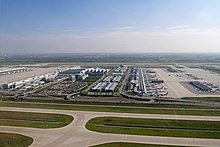
Munich Airport with Terminal 1, Terminal 2 and Munich Airport Center

Freeway junction Oberpfälzer Wald (2011)

Map of airports and landing fields in Bavaria

Headquarters of the Kicker editorial office in Nuremberg with the Kicker statue in front of the main entrance
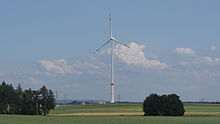
Wind turbine of the Berching wind farm
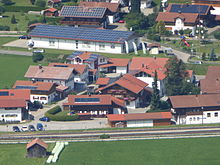
Various roofs with photovoltaic systems in Oberstdorf
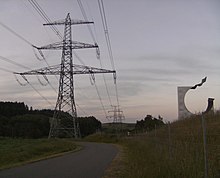
The 380 kV Etzenricht-Hradec line crosses the state border between Germany and the Czech Republic. The pylon in the foreground is located in Bavaria, the one in the background in the Czech Republic.
.jpg)
Isar nuclear power plant

One of the most famous tourist attractions in Bavaria is Rothenburg ob der Tauber.
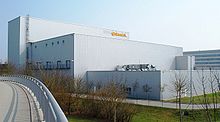
Continental Automotive, Regensburg

German headquarters of the world's largest rolling bearing group SKF in Schweinfurt
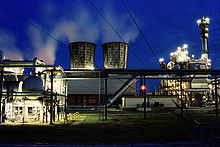
The gun pre-refinery (formerly Petroplus, Esso) in Ingolstadt
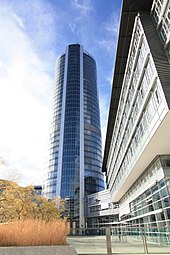
The Business Tower Nuremberg is one of the tallest buildings in the Free State of Bavaria
Education
School system
There are about 5500 schools in the Free State of Bavaria, which operate according to the Bavarian Law on Education and Teaching. The four-year elementary school is followed by the three-tier school system with middle school, junior high school and high school with Abitur after the 12th grade. From the 7th grade, there is the option of attending a business school, and from the 10th, a vocational high school (Fachoberschule and Berufsoberschule) with attainment of the Bavarian Abitur after the 13th grade.
Students with a certificate of completion from a Realschule, Wirtschaftsschule or M-Zug at secondary schools can transfer to so-called introductory classes at selected Gymnasien and, if they successfully pass, transfer to the 11th grade of the Gymnasium. Under certain conditions, it is also possible to transfer to the 11th grade without attending the introductory class or to transfer to the regular 10th grade of the Gymnasium. In addition, there are special education schools and schools for the sick. The school system is generally permeable, and every student who achieves a diploma has access to the next higher level of schooling.
As schools of a special kind, there are five comprehensive schools in Bavaria. Furthermore, there are numerous boarding schools, private schools and second-chance educational institutions in Bavaria. A special feature of the Bavarian education system is the school preparation facilities for children with special educational needs, which do not exist in this form in any other federal state. Other special features of the Bavarian school system are grade level tests, the Absentenheftführer and the Elitenetzwerk Bayern (Bavarian Elite Network) for top academic training.
Bavaria's students regularly achieve top rankings in the PISA studies conducted by the OECD.
In the overall German education comparison, Bavaria (as of 2019) is in second place behind Saxony.
See also: List of high schools in Bavaria and basic concepts of science in the Bavarian curriculum
Universities and colleges
In Bavaria, there are nine state universities of the Free State, as well as the University of the Federal Armed Forces Munich. Until 1962, only four universities existed in Munich (LMU, TU), Würzburg and Erlangen (from 1966 Erlangen-Nuremberg). Between 1962 and 1975, five more were founded by the Free State in Regensburg, Augsburg, Bamberg, Bayreuth and Passau. In addition, the newly founded Bundeswehr University was founded in 1973. Since 2018, the Technical University of Nuremberg has been the tenth state university to be established.
In addition, there are 18 state universities of applied sciences in Bavaria, such as those in Aschaffenburg, Hof, Landshut, Kempten and Nuremberg, which were founded between 1971 and 1996. In addition, there is an ecclesiastical university, the Catholic University of Eichstätt-Ingolstadt, founded in 1980, as well as four other private or ecclesiastical universities and 10 art colleges.
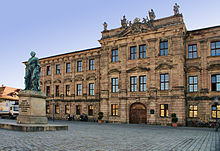
Erlangen Castle : Completed in 1702 as a margravial residence, the castle passed to the University of Erlangen in 1817.
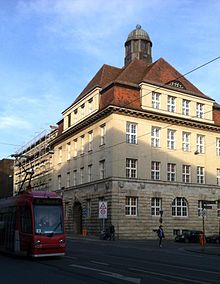
Founded in 1526, the Melanchthon Gymnasium in Nuremberg is considered the oldest grammar school in the German-speaking world.
Sports
Ball sports
Soccer is one of the most popular sports. The Bavarian Football Association has around 1.5 million members, making it the association with the most members in the German Football Association. FC Bayern München is internationally known and is the record champion of the Bundesliga, to which it has belonged since 1965, as well as being a multiple winner of international soccer competitions such as the UEFA Champions League. FC Augsburg has also played in Germany's top division since 2011. Four Bavarian clubs currently play in the second-highest division, the 2nd Bundesliga: Nine-time German champions and long-time record holders 1. FC Nürnberg, three-time German champions SpVgg Greuther Fürth, SSV Jahn Regensburg and Würzburger Kickers. In the 2020/21 season, FC Ingolstadt 04, SpVgg Unterhaching, long-time first division team TSV 1860 München, Türkgücü München and FC Bayern München's second team will also play in the 3rd Football League. 1. FC Nürnberg ranks second in terms of the number of championship trophies won.
The women's Bundesliga also features the FC Bayern Munich team, German champions in 1976, 2015 and 2016.
In volleyball, the 1st Bundesliga includes the multiple German women's champions Roten Raben Vilsbiburg and NawaRo Straubing, as well as the men's teams of WWK Volleys Herrsching and TSV Unterhaching.
The basketball teams of Brose Bamberg, medi Bayreuth, Bayern Munich and s.Oliver Würzburg play in Germany's top division. Brose Bamberg was German champion in 2005, 2007, 2010, 2011, 2012, 2013 and 2015 and cup winner in 2010, 2011 and 2012. In women's basketball, the TSV Wasserburg team, which plays in the 1st Bundesliga, won the German championship title from 2004 to 2007 and was also German Cup winner from 2005 to 2007.
Currently (2020/21 season), HC Erlangen and HSC 2000 Coburg (both in the Bundesliga) are the highest-ranked men's handball clubs in the Free State of Bavaria. The handball department of TV Großwallstadt from the district of Miltenberg played in the 1st Handball Bundesliga for many years and now plays in the 2nd Bundesliga, in which DJK Rimpar is also represented. Well-known, although equally no longer first-class, are the Munich clubs TSV Milbertshofen and MTSV Schwabing.
In women's handball, 1. FC Nürnberg is the most successful Bavarian team. In the recent past, they were German champions in 2005, 2007 and 2008 and advanced to the main round of the EHF Champions League in 2007/2008.
Every year, Munich hosts a major tennis tournament sponsored by BMW: The BMW Open. They are considered the gateway to later careers. Renowned tennis players from all over the world travel there to take home important ATP points. Female tennis players take part in the WTA competitions. A major WTA tournament, the Nuremberg Insurance Cup has been held annually in Nuremberg since 2013. Well-known representatives of Bavarian tennis are Philipp Kohlschreiber from Augsburg and David Prinosil from Amberg. Bavaria leads Germany with 163 golf courses, and Upper Bavaria, together with the Hamburg metropolitan region, has the highest density of golf courses. There are 110,000 registered active golfers.
In baseball, more and more teams have emerged in recent years that play successfully in the 1st and 2nd Baseball Bundesliga. These include the German champions of the 2008, 2010 and 2011 seasons from Regensburg, the Regensburg Legionnaires. Other successful Bavarian teams include the Gauting Indians, the Ingolstadt Schanzers and the Haar Disciples. At the state association level, Bavarian clubs include the Augsburg Gators, Erlangen White Sox, Fürth Pirates, Deggendorf Dragons and Garching Atomics. With around 60 registered clubs, the BBSV, the Bavarian Baseball and Softball Association, is one of the largest in Germany.
In American football, Bavaria is also represented by several teams in the highest divisions. In the Bundesliga, called GFL (German Football League), the Munich Cowboys, the Ingolstadt Dukes and the Allgäu Comets from Kempten play. In the second highest division, GFL2, three Bavarian teams are represented, the Kirchdorf Wildcats, the Straubing Spiders and the Fursty Razorbacks. In women's soccer, the Munich Cowboys Ladies and the München Rangers Ladies are represented in the Bundesliga, as are the Allgäu Comets Ladies, the Nürnberg Rams Ladies and the Regensburg Phoenix Ladies in the second division.
Korbball is played mainly in Franconia, but also in the Allgäu region. Schweinfurt has been considered the center of korfball since 1937. In the region, more than 80 clubs participate in the game.
Winter sports
Especially in the alpine region, winter sports have traditionally been of great importance. Favorable conditions for ski racing can be found in the Bavarian Alps. The outstanding representatives of this sport are Mirl Buchner, Heidi Biebl, Rosi Mittermaier, Marina Kiehl, Christa Kinshofer, Martina Ertl-Renz, Hilde Gerg, Maria Höfl-Riesch, Franz Pfnür and Markus Wasmeier. Numerous winners of international competitions have emerged from the Biathlon National Training Center in Ruhpolding, the most famous among them being Fritz Fischer, Michael Greis, Uschi Disl, Martina Glagow and Magdalena Neuner. In cross-country skiing, Tobias Angerer and Evi Sachenbacher-Stehle achieved significant results.
In Bavaria, there are five ice hockey clubs in the German Ice Hockey League; the Augsburg Panthers, the ERC Ingolstadt, the EHC Red Bull Munich, the Nürnberg Ice Tigers and the Straubing Tigers. The teams of EHC Bayreuth, EV Landshut, ESV Kaufbeuren and Tölzer Löwen play in the DEL2. In the Oberliga Süd, all 12 teams are from Bavaria, although the southern group theoretically also includes Baden-Württemberg and southern Saxony. Other clubs that are particularly well-known for their work with young talent are Starbulls Rosenheim and EV Füssen.
Especially in the area of the Oberallgäu town of Oberstdorf and in Garmisch-Partenkirchen, numerous sporting events take place, such as the first two jumps of the Four Hills Tournament. The 1936 Winter Olympics were held in Garmisch. Numerous world and European championships, for example in luge, figure skating, curling or ski flying, also took place there.
See also: Ice field hockey in Bavaria
Other sports
Not least through the documentary film Am Limit, the sport climbers Thomas and Alexander Huber became known to a wider audience. Bavarians were also among the world's best summit climbers in the past, including Johann Grill, Josef Enzensperger, Otto Herzog, Anderl Heckmair and Toni Schmid.
In Bavaria, some traditional sports have survived, such as fingerhaking and curling, which are played in organized leagues. Sautrogrennen is also one of the Bavarian traditional sports. This sport is particularly popular in southern Bavaria on the Danube, Iller, Isar and Lech rivers. In Franconia, this sport is honored on the occasion of folk festivals in the mostly still existing local village or fire water ponds. With the greatest amusement of the spectators, serious regional and national championships are contested, and since 2010 in Schwarzenbach an der Saale even real world championships.
In the field of motor sports, there are the annual touring car races for the DTM at the Norisring in Nuremberg-Dutzendteich. Speedway races are held in Landshut, Pocking, Abensberg and Olching, as well as sand track races in Mühldorf am Inn, Pfarrkirchen, Vilshofen, Dingolfing and Plattling. There are international ice speedway races in Inzell. Sport shooting is practiced throughout the state in the disciplines of rifle, pistol, bow, clay target, running target and crossbow. The Bavarian Shooting Association (BSSB) is the fourth largest sports association in the state. Many Bavarian participants in the Olympic Games have already achieved success.
In the dance sport, the Latin and Standard Formation of the RGC Nuremberg dance in the second national league. In the individual dance area there are very many successful dancers. Many gymnastics clubs have a long tradition in Bavaria. The state performance center was in Nuremberg, but was merged with the federal performance center in Frankfurt am Main. Centers are Augsburg, Würzburg, Schweinfurt, Nuremberg, Landshut, Passau and Rosenheim. Bavarian gymnasts often occupied top positions worldwide in the 1920s.
There has been a "Bavarian Children's Gymnastics Olympics" for children since 2000. The venue was Neumarkt in der Oberpfalz five times, in 2000, 2004, 2008, 2012 and 2016. In 2012, Neumarkt also hosted the 31st Gymnastics Youth Festival as part of the Children's Gymnastics Olympics. In 2020, the next Children's Gymnastics Olympics will be held.
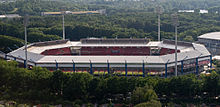
The Max Morlock Stadium is the home stadium of 1. FC Nuremberg

The Allianz Arena, home stadium of FC Bayern Munich

Schattenberg ski jump in Oberstdorf at the opening jump of the Four Hills Tournament on December 30, 2006
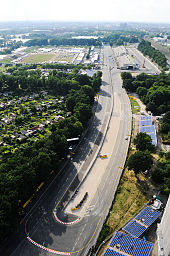
The Nuremberg Norisring
Statistics and studies
Crime rate
In a Germany-wide comparison, Bavaria has a very low crime rate. In 2017, there were 4868 crimes per 100,000 inhabitants, according to police crime statistics. This was the lowest value among all German states.
Private insolvencies
Bavaria had the lowest rate of private insolvencies of all the German states in 2017. Per 100,000 citizens, only 86 were insolvent. The average for Germany as a whole is 123 private insolvencies per 100,000 inhabitants. Bremen had the highest number, at 212.
Xenophobia
According to the so-called Mitte study conducted by the University of Leipzig in 2015, 33.1% of Bavarians agree with xenophobic statements. That was the second-highest figure in a state comparison after Saxony-Anhalt. There, the figure was 42.2%. The national average is 24.3. In addition, of all the German states, Bavaria has the highest level of agreement with anti-Semitic statements at 12.6% (national average: 8.4%). Thus, xenophobic and anti-Semitic attitudes would be widespread in Bavaria.
A 2016 study by LMU Munich, on the other hand, came to a more differentiated picture. According to the study, hostile attitudes toward foreigners in general hardly met with approval, but 56% of Bavarians were specifically hostile toward Muslims, 32% toward refugees and 21% anti-Semitic.
See also
![]()
Portal: Bavaria - Overview of Wikipedia content on Bavaria
Search within the encyclopedia


.svg.png)
.svg.png)

